Overview
- Brief Narrative
- 20 (zwanzig) mark receipt issued in the Łódź ghetto in Poland beginning in May 1940 until the ghetto was liquidated in summer 1944. Nazi Germany invaded Poland on September 1, 1939, and occupied Łódź one week later. Łódź was renamed Litzmannstadt and, by February 1940, the Germans forcibly relocated the large Jewish population of 160,000 into a small, sealed ghetto. All residents had to work and many were forced laborers in ghetto factories. Residents were forbidden to have German currency, and the Jewish Council was ordered to create a system of Quittungen [receipts] that could be used only in the ghetto. The scrip, sometimes referred to as rumkis, after the Elder of the Judenrat, Mordechai Rumkowski, was issued in 7 denominations: 50 pfenning, 1, 2, 5, 10, 20, 50, and 100 marks, as well as coins. It acted as a labor incentive and facilitated the confiscation of money and goods from internees. There was little to exchange it for in the ghetto. Living conditions were horrendous; the severe overcrowding and lack of food made disease and starvation common. In January 1942, mass deportations to Chelmno killing center began; half the residents were murdered by the end of the year. In summer 1944, Łódź, the last ghetto in Poland, was destroyed and the remaining Jews were sent to Chelmno and Auschwitz-Birkenau killing centers.
- Date
-
issue:
1940 May 15
- Geography
-
issue:
Litzmannstadt-Getto (Łódź, Poland);
Łódź (Poland)
- Credit Line
- United States Holocaust Memorial Museum Collection, Gift of the Żydowski Instytut Historyczny im. Emanuela Ringelbluma
- Markings
- face, upper left, red ink : Nº 144347
face, lower left and upper right corner, black ink : 20
face, center, black ink : Quittung / über / Zwanzig Mark / Der Aelteste der Juden / in Litzmannstadt / M. Rumkowski / Litzmannstadt, den 15 Mai 1940 [Receipt for Twenty mark / The Elder of the Jews in Litzmannstadt M Rumkowski / Litzmannstadt May 15 1940]
back, upper left corner, black ink : Quittung über / Zwanzig Mark
back, bottom, black ink : WER DIESE QUITTUNG VERFÄLSCHT ODER NACHMACHT ODER GEFÄLSCHTE / QUITTUNGEN IN VERKEHR BRINGT / WIRD STRENGSTENS BESTRAFT [Anyone who falsifies or copies this receipt, or traffics in counterfeit receipts, will be strictly punished]
back, lower right, black ink : 20
Physical Details
- Language
- German
- Classification
-
Exchange Media
- Category
-
Money
- Object Type
-
Scrip (aat)
- Genre/Form
- Money
- Physical Description
- Lodz ghetto scrip torn in 2 pieces printed on rectangular offwhite paper in brown and black ink. The face has a latticework underprint. The serial number is in red in the upper left corner. The denomination 20 is in the lower left corner and in the upper right corner in a black square. There is a 1.5 inch left margin, then a rectangle with a rounded upper left corner with a pattern of interlocked Stars of David resemblnig barbed wire and an encircled Star of David in the upper left corner. Across the center is the denomination Zwanzig Mark and German text. The back has a blank 1.5 inch right margin and a rectangle with the same pattern of interlocked Stars of David. In the upper left corner is the denomination Zwanzig Mark and in the lower left corner is a menorah or 7-branched candelabrum. The denomination 20 is outside the lower right corner of the rectangle; above this, near the upper right corner, is a Star of David outline in a black square. The scrip is extremely worn, soiled, and torn, with adhesive tape holding the 2 sections together.
- Dimensions
- overall: Height: 3.125 inches (7.938 cm) | Width: 6.250 inches (15.875 cm)
- Materials
- overall : paper, ink
Rights & Restrictions
- Conditions on Access
- No restrictions on access
- Conditions on Use
- No restrictions on use
Keywords & Subjects
Administrative Notes
- Legal Status
- Permanent Collection
- Provenance
- The scrip was donated to the United States Holocaust Memorial Museum in 1987 by the Zydowski Instytut Historyczny im. Emanuela Ringelbluma.
- Funding Note
- The cataloging of this artifact has been supported by a grant from the Conference on Jewish Material Claims Against Germany.
- Record last modified:
- 2024-06-25 09:43:26
- This page:
- https://collections.ushmm.org/search/catalog/irn16606
Download & Licensing
In-Person Research
- By Appointment
- Request 21 Days in Advance of Visit
- Plan a Research Visit
- Request to See This Object
Contact Us
Also in Zydowski Instytut Historyczny im. Emanuela Ringelbluma collection
The collection consists of seventy-eight pieces of scrip and sixteen coins issued in the Łódź (Litzmannstadt) ghetto in German occupied Poland, one bar of soap, and one flight logbook from the Nationalsozialistisches Fliegerkorps used during World War II.
Date: approximately 1940-1942

Łódź (Litzmannstadt) ghetto scrip, 20 mark note
Object
20 (zwanzig) mark receipt issued in the Łódź ghetto in Poland beginning in May 1940 until the ghetto was liquidated in summer 1944. Nazi Germany invaded Poland on September 1, 1939, and occupied Łódź one week later. Łódź was renamed Litzmannstadt and, by February 1940, the Germans forcibly relocated the large Jewish population of 160,000 into a small, sealed ghetto. All residents had to work and many were forced laborers in ghetto factories. Residents were forbidden to have German currency, and the Jewish Council was ordered to create a system of Quittungen [receipts] that could be used only in the ghetto. The scrip, sometimes referred to as rumkis, after the Elder of the Judenrat, Mordechai Rumkowski, was issued in 7 denominations: 50 pfenning, 1, 2, 5, 10, 20, 50, and 100 marks, as well as coins. It acted as a labor incentive and facilitated the confiscation of money and goods from internees. There was little to exchange it for in the ghetto. Living conditions were horrendous; the severe overcrowding and lack of food made disease and starvation common. In January 1942, mass deportations to Chelmno killing center began; half the residents were murdered by the end of the year. In summer 1944, Łódź, the last ghetto in Poland, was destroyed and the remaining Jews were sent to Chelmno and Auschwitz-Birkenau killing centers.

Łódź (Litzmannstadt) ghetto scrip, 20 mark note
Object
20 (zwanzig) mark receipt issued in the Łódź ghetto in Poland beginning in May 1940 until the ghetto was liquidated in summer 1944. Nazi Germany invaded Poland on September 1, 1939, and occupied Łódź one week later. Łódź was renamed Litzmannstadt and, by February 1940, the Germans forcibly relocated the large Jewish population of 160,000 into a small, sealed ghetto. All residents had to work and many were forced laborers in ghetto factories. Residents were forbidden to have German currency, and the Jewish Council was ordered to create a system of Quittungen [receipts] that could be used only in the ghetto. The scrip, sometimes referred to as rumkis, after the Elder of the Judenrat, Mordechai Rumkowski, was issued in 7 denominations: 50 pfenning, 1, 2, 5, 10, 20, 50, and 100 marks, as well as coins. It acted as a labor incentive and facilitated the confiscation of money and goods from internees. There was little to exchange it for in the ghetto. Living conditions were horrendous; the severe overcrowding and lack of food made disease and starvation common. In January 1942, mass deportations to Chelmno killing center began; half the residents were murdered by the end of the year. In summer 1944, Łódź, the last ghetto in Poland, was destroyed and the remaining Jews were sent to Chelmno and Auschwitz-Birkenau killing centers.
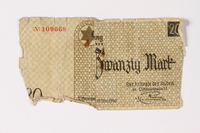
Łódź (Litzmannstadt) ghetto scrip, 20 mark note
Object
20 (zwanzig) mark receipt issued in the Łódź ghetto in Poland beginning in May 1940 until the ghetto was liquidated in summer 1944. Nazi Germany invaded Poland on September 1, 1939, and occupied Łódź one week later. Łódź was renamed Litzmannstadt and, by February 1940, the Germans forcibly relocated the large Jewish population of 160,000 into a small, sealed ghetto. All residents had to work and many were forced laborers in ghetto factories. Residents were forbidden to have German currency, and the Jewish Council was ordered to create a system of Quittungen [receipts] that could be used only in the ghetto. The scrip, sometimes referred to as rumkis, after the Elder of the Judenrat, Mordechai Rumkowski, was issued in 7 denominations: 50 pfenning, 1, 2, 5, 10, 20, 50, and 100 marks, as well as coins. It acted as a labor incentive and facilitated the confiscation of money and goods from internees. There was little to exchange it for in the ghetto. Living conditions were horrendous; the severe overcrowding and lack of food made disease and starvation common. In January 1942, mass deportations to Chelmno killing center began; half the residents were murdered by the end of the year. In summer 1944, Łódź, the last ghetto in Poland, was destroyed and the remaining Jews were sent to Chelmno and Auschwitz-Birkenau killing centers.
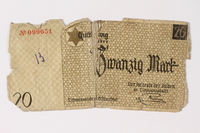
Łódź (Litzmannstadt) ghetto scrip, 20 mark note
Object
20 (zwanzig) mark receipt issued in the Łódź ghetto in Poland beginning in May 1940 until the ghetto was liquidated in summer 1944. Nazi Germany invaded Poland on September 1, 1939, and occupied Łódź one week later. Łódź was renamed Litzmannstadt and, by February 1940, the Germans forcibly relocated the large Jewish population of 160,000 into a small, sealed ghetto. All residents had to work and many were forced laborers in ghetto factories. Residents were forbidden to have German currency, and the Jewish Council was ordered to create a system of Quittungen [receipts] that could be used only in the ghetto. The scrip, sometimes referred to as rumkis, after the Elder of the Judenrat, Mordechai Rumkowski, was issued in 7 denominations: 50 pfenning, 1, 2, 5, 10, 20, 50, and 100 marks, as well as coins. It acted as a labor incentive and facilitated the confiscation of money and goods from internees. There was little to exchange it for in the ghetto. Living conditions were horrendous; the severe overcrowding and lack of food made disease and starvation common. In January 1942, mass deportations to Chelmno killing center began; half the residents were murdered by the end of the year. In summer 1944, Łódź, the last ghetto in Poland, was destroyed and the remaining Jews were sent to Chelmno and Auschwitz-Birkenau killing centers.
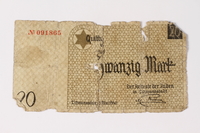
Łódź (Litzmannstadt) ghetto scrip, 20 mark note
Object
20 (zwanzig) mark receipt issued in the Łódź ghetto in Poland beginning in May 1940 until the ghetto was liquidated in summer 1944. Nazi Germany invaded Poland on September 1, 1939, and occupied Łódź one week later. Łódź was renamed Litzmannstadt and, by February 1940, the Germans forcibly relocated the large Jewish population of 160,000 into a small, sealed ghetto. All residents had to work and many were forced laborers in ghetto factories. Residents were forbidden to have German currency, and the Jewish Council was ordered to create a system of Quittungen [receipts] that could be used only in the ghetto. The scrip, sometimes referred to as rumkis, after the Elder of the Judenrat, Mordechai Rumkowski, was issued in 7 denominations: 50 pfenning, 1, 2, 5, 10, 20, 50, and 100 marks, as well as coins. It acted as a labor incentive and facilitated the confiscation of money and goods from internees. There was little to exchange it for in the ghetto. Living conditions were horrendous; the severe overcrowding and lack of food made disease and starvation common. In January 1942, mass deportations to Chelmno killing center began; half the residents were murdered by the end of the year. In summer 1944, Łódź, the last ghetto in Poland, was destroyed and the remaining Jews were sent to Chelmno and Auschwitz-Birkenau killing centers.
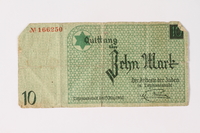
Łódź (Litzmannstadt) ghetto scrip, 10 mark note
Object
10 (zehn) mark receipt issued in the Łódź ghetto in Poland beginning in May 1940 until the ghetto was liquidated in summer 1944. Nazi Germany invaded Poland on September 1, 1939, and occupied Łódź one week later. Łódź was renamed Litzmannstadt and, by February 1940, the Germans forcibly relocated the large Jewish population of 160,000 into a small, sealed ghetto. All residents had to work and many were forced laborers in ghetto factories. Residents were forbidden to have German currency, and the Jewish Council was ordered to create a system of Quittungen [receipts] that could be used only in the ghetto. The scrip, sometimes referred to as rumkis, after the Elder of the Judenrat, Mordechai Rumkowski, was issued in 7 denominations: 50 pfenning, 1, 2, 5, 10, 20, 50, and 100 marks, as well as coins. It acted as a labor incentive and facilitated the confiscation of money and goods from internees. There was little to exchange it for in the ghetto. Living conditions were horrendous; the severe overcrowding and lack of food made disease and starvation common. In January 1942, mass deportations to Chelmno killing center began; half the residents were murdered by the end of the year. In summer 1944, Łódź, the last ghetto in Poland, was destroyed and the remaining Jews were sent to Chelmno and Auschwitz-Birkenau killing centers.

Łódź (Litzmannstadt) ghetto scrip, 10 mark note
Object
10 (zehn) mark receipt issued in the Łódź ghetto in Poland beginning in May 1940 until the ghetto was liquidated in summer 1944. Nazi Germany invaded Poland on September 1, 1939, and occupied Łódź one week later. Łódź was renamed Litzmannstadt and, by February 1940, the Germans forcibly relocated the large Jewish population of 160,000 into a small, sealed ghetto. All residents had to work and many were forced laborers in ghetto factories. Residents were forbidden to have German currency, and the Jewish Council was ordered to create a system of Quittungen [receipts] that could be used only in the ghetto. The scrip, sometimes referred to as rumkis, after the Elder of the Judenrat, Mordechai Rumkowski, was issued in 7 denominations: 50 pfenning, 1, 2, 5, 10, 20, 50, and 100 marks, as well as coins. It acted as a labor incentive and facilitated the confiscation of money and goods from internees. There was little to exchange it for in the ghetto. Living conditions were horrendous; the severe overcrowding and lack of food made disease and starvation common. In January 1942, mass deportations to Chelmno killing center began; half the residents were murdered by the end of the year. In summer 1944, Łódź, the last ghetto in Poland, was destroyed and the remaining Jews were sent to Chelmno and Auschwitz-Birkenau killing centers.
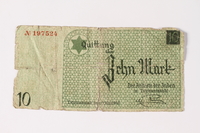
Łódź (Litzmannstadt) ghetto scrip, 10 mark note
Object
10 (zehn) mark receipt issued in the Łódź ghetto in Poland beginning in May 1940 until the ghetto was liquidated in summer 1944. Nazi Germany invaded Poland on September 1, 1939, and occupied Łódź one week later. Łódź was renamed Litzmannstadt and, by February 1940, the Germans forcibly relocated the large Jewish population of 160,000 into a small, sealed ghetto. All residents had to work and many were forced laborers in ghetto factories. Residents were forbidden to have German currency, and the Jewish Council was ordered to create a system of Quittungen [receipts] that could be used only in the ghetto. The scrip, sometimes referred to as rumkis, after the Elder of the Judenrat, Mordechai Rumkowski, was issued in 7 denominations: 50 pfenning, 1, 2, 5, 10, 20, 50, and 100 marks, as well as coins. It acted as a labor incentive and facilitated the confiscation of money and goods from internees. There was little to exchange it for in the ghetto. Living conditions were horrendous; the severe overcrowding and lack of food made disease and starvation common. In January 1942, mass deportations to Chelmno killing center began; half the residents were murdered by the end of the year. In summer 1944, Łódź, the last ghetto in Poland, was destroyed and the remaining Jews were sent to Chelmno and Auschwitz-Birkenau killing centers.
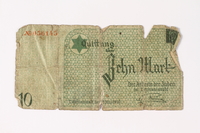
Łódź (Litzmannstadt) ghetto scrip, 10 mark note
Object
10 (zehn) mark receipt issued in the Łódź ghetto in Poland beginning in May 1940 until the ghetto was liquidated in summer 1944. Nazi Germany invaded Poland on September 1, 1939, and occupied Łódź one week later. Łódź was renamed Litzmannstadt and, by February 1940, the Germans forcibly relocated the large Jewish population of 160,000 into a small, sealed ghetto. All residents had to work and many were forced laborers in ghetto factories. Residents were forbidden to have German currency, and the Jewish Council was ordered to create a system of Quittungen [receipts] that could be used only in the ghetto. The scrip, sometimes referred to as rumkis, after the Elder of the Judenrat, Mordechai Rumkowski, was issued in 7 denominations: 50 pfenning, 1, 2, 5, 10, 20, 50, and 100 marks, as well as coins. It acted as a labor incentive and facilitated the confiscation of money and goods from internees. There was little to exchange it for in the ghetto. Living conditions were horrendous; the severe overcrowding and lack of food made disease and starvation common. In January 1942, mass deportations to Chelmno killing center began; half the residents were murdered by the end of the year. In summer 1944, Łódź, the last ghetto in Poland, was destroyed and the remaining Jews were sent to Chelmno and Auschwitz-Birkenau killing centers.

Łódź (Litzmannstadt) ghetto scrip, 10 mark note
Object
10 (zehn) mark receipt issued in the Łódź ghetto in Poland beginning in May 1940 until the ghetto was liquidated in summer 1944. Nazi Germany invaded Poland on September 1, 1939, and occupied Łódź one week later. Łódź was renamed Litzmannstadt and, by February 1940, the Germans forcibly relocated the large Jewish population of 160,000 into a small, sealed ghetto. All residents had to work and many were forced laborers in ghetto factories. Residents were forbidden to have German currency, and the Jewish Council was ordered to create a system of Quittungen [receipts] that could be used only in the ghetto. The scrip, sometimes referred to as rumkis, after the Elder of the Judenrat, Mordechai Rumkowski, was issued in 7 denominations: 50 pfenning, 1, 2, 5, 10, 20, 50, and 100 marks, as well as coins. It acted as a labor incentive and facilitated the confiscation of money and goods from internees. There was little to exchange it for in the ghetto. Living conditions were horrendous; the severe overcrowding and lack of food made disease and starvation common. In January 1942, mass deportations to Chelmno killing center began; half the residents were murdered by the end of the year. In summer 1944, Łódź, the last ghetto in Poland, was destroyed and the remaining Jews were sent to Chelmno and Auschwitz-Birkenau killing centers.
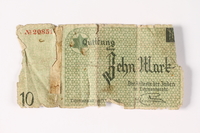
Łódź (Litzmannstadt) ghetto scrip, 10 mark note
Object
10 (zehn) mark receipt issued in the Łódź ghetto in Poland beginning in May 1940 until the ghetto was liquidated in summer 1944. Nazi Germany invaded Poland on September 1, 1939, and occupied Łódź one week later. Łódź was renamed Litzmannstadt and, by February 1940, the Germans forcibly relocated the large Jewish population of 160,000 into a small, sealed ghetto. All residents had to work and many were forced laborers in ghetto factories. Residents were forbidden to have German currency, and the Jewish Council was ordered to create a system of Quittungen [receipts] that could be used only in the ghetto. The scrip, sometimes referred to as rumkis, after the Elder of the Judenrat, Mordechai Rumkowski, was issued in 7 denominations: 50 pfenning, 1, 2, 5, 10, 20, 50, and 100 marks, as well as coins. It acted as a labor incentive and facilitated the confiscation of money and goods from internees. There was little to exchange it for in the ghetto. Living conditions were horrendous; the severe overcrowding and lack of food made disease and starvation common. In January 1942, mass deportations to Chelmno killing center began; half the residents were murdered by the end of the year. In summer 1944, Łódź, the last ghetto in Poland, was destroyed and the remaining Jews were sent to Chelmno and Auschwitz-Birkenau killing centers.
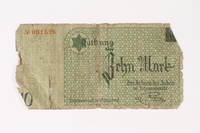
Łódź (Litzmannstadt) ghetto scrip, 10 mark note
Object
10 (zehn) mark receipt issued in the Łódź ghetto in Poland beginning in May 1940 until the ghetto was liquidated in summer 1944. Nazi Germany invaded Poland on September 1, 1939, and occupied Łódź one week later. Łódź was renamed Litzmannstadt and, by February 1940, the Germans forcibly relocated the large Jewish population of 160,000 into a small, sealed ghetto. All residents had to work and many were forced laborers in ghetto factories. Residents were forbidden to have German currency, and the Jewish Council was ordered to create a system of Quittungen [receipts] that could be used only in the ghetto. The scrip, sometimes referred to as rumkis, after the Elder of the Judenrat, Mordechai Rumkowski, was issued in 7 denominations: 50 pfenning, 1, 2, 5, 10, 20, 50, and 100 marks, as well as coins. It acted as a labor incentive and facilitated the confiscation of money and goods from internees. There was little to exchange it for in the ghetto. Living conditions were horrendous; the severe overcrowding and lack of food made disease and starvation common. In January 1942, mass deportations to Chelmno killing center began; half the residents were murdered by the end of the year. In summer 1944, Łódź, the last ghetto in Poland, was destroyed and the remaining Jews were sent to Chelmno and Auschwitz-Birkenau killing centers.

Łódź (Litzmannstadt) ghetto scrip, 10 mark note
Object
10 (zehn) mark receipt issued in the Łódź ghetto in Poland beginning in May 1940 until the ghetto was liquidated in summer 1944. Nazi Germany invaded Poland on September 1, 1939, and occupied Łódź one week later. Łódź was renamed Litzmannstadt and, by February 1940, the Germans forcibly relocated the large Jewish population of 160,000 into a small, sealed ghetto. All residents had to work and many were forced laborers in ghetto factories. Residents were forbidden to have German currency, and the Jewish Council was ordered to create a system of Quittungen [receipts] that could be used only in the ghetto. The scrip, sometimes referred to as rumkis, after the Elder of the Judenrat, Mordechai Rumkowski, was issued in 7 denominations: 50 pfenning, 1, 2, 5, 10, 20, 50, and 100 marks, as well as coins. It acted as a labor incentive and facilitated the confiscation of money and goods from internees. There was little to exchange it for in the ghetto. Living conditions were horrendous; the severe overcrowding and lack of food made disease and starvation common. In January 1942, mass deportations to Chelmno killing center began; half the residents were murdered by the end of the year. In summer 1944, Łódź, the last ghetto in Poland, was destroyed and the remaining Jews were sent to Chelmno and Auschwitz-Birkenau killing centers.
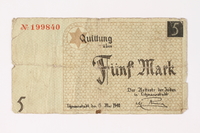
Łódź (Litzmannstadt) ghetto scrip, 5 mark note
Object
5 (funf) mark receipt issued in the Łódź ghetto in Poland beginning in May 1940 until the ghetto was liquidated in summer 1944. Nazi Germany invaded Poland on September 1, 1939, and occupied Łódź one week later. Łódź was renamed Litzmannstadt and, by February 1940, the Germans forcibly relocated the large Jewish population of 160,000 into a small, sealed ghetto. All residents had to work and many were forced laborers in ghetto factories. Residents were forbidden to have German currency, and the Jewish Council was ordered to create a system of Quittungen [receipts] that could be used only in the ghetto. The scrip, sometimes referred to as rumkis, after the Elder of the Judenrat, Mordechai Rumkowski, was issued in 7 denominations: 50 pfenning, 1, 2, 5, 10, 20, and 50 marks, as well as coins. It acted as a labor incentive and facilitated the confiscation of money and goods from internees. There was little to exchange it for in the ghetto. Living conditions were horrendous; the severe overcrowding and lack of food made disease and starvation common. In January 1942, mass deportations to Chelmno killing center began; half the residents were murdered by the end of the year. In summer 1944, Łódź, the last ghetto in Poland, was destroyed and the remaining Jews were sent to Chelmno and Auschwitz-Birkenau killing centers.
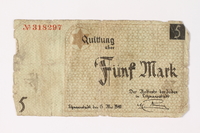
Łódź (Litzmannstadt) ghetto scrip, 5 mark note
Object
5 (funf) mark receipt issued in the Łódź ghetto in Poland beginning in May 1940 until the ghetto was liquidated in summer 1944. Nazi Germany invaded Poland on September 1, 1939, and occupied Łódź one week later. Łódź was renamed Litzmannstadt and, by February 1940, the Germans forcibly relocated the large Jewish population of 160,000 into a small, sealed ghetto. All residents had to work and many were forced laborers in ghetto factories. Residents were forbidden to have German currency, and the Jewish Council was ordered to create a system of Quittungen [receipts] that could be used only in the ghetto. The scrip, sometimes referred to as rumkis, after the Elder of the Judenrat, Mordechai Rumkowski, was issued in 7 denominations: 50 pfenning, 1, 2, 5, 10, 20, and 50 marks, as well as coins. It acted as a labor incentive and facilitated the confiscation of money and goods from internees. There was little to exchange it for in the ghetto. Living conditions were horrendous; the severe overcrowding and lack of food made disease and starvation common. In January 1942, mass deportations to Chelmno killing center began; half the residents were murdered by the end of the year. In summer 1944, Łódź, the last ghetto in Poland, was destroyed and the remaining Jews were sent to Chelmno and Auschwitz-Birkenau killing centers.

Łódź (Litzmannstadt) ghetto scrip, 5 mark note
Object
5 (funf) mark receipt issued in the Łódź ghetto in Poland beginning in May 1940 until the ghetto was liquidated in summer 1944. Nazi Germany invaded Poland on September 1, 1939, and occupied Łódź one week later. Łódź was renamed Litzmannstadt and, by February 1940, the Germans forcibly relocated the large Jewish population of 160,000 into a small, sealed ghetto. All residents had to work and many were forced laborers in ghetto factories. Residents were forbidden to have German currency, and the Jewish Council was ordered to create a system of Quittungen [receipts] that could be used only in the ghetto. The scrip, sometimes referred to as rumkis, after the Elder of the Judenrat, Mordechai Rumkowski, was issued in 7 denominations: 50 pfenning, 1, 2, 5, 10, 20, and 50 marks, as well as coins. It acted as a labor incentive and facilitated the confiscation of money and goods from internees. There was little to exchange it for in the ghetto. Living conditions were horrendous; the severe overcrowding and lack of food made disease and starvation common. In January 1942, mass deportations to Chelmno killing center began; half the residents were murdered by the end of the year. In summer 1944, Łódź, the last ghetto in Poland, was destroyed and the remaining Jews were sent to Chelmno and Auschwitz-Birkenau killing centers.

Łódź (Litzmannstadt) ghetto scrip, 5 mark note
Object
5 (funf) mark receipt issued in the Łódź ghetto in Poland beginning in May 1940 until the ghetto was liquidated in summer 1944. Nazi Germany invaded Poland on September 1, 1939, and occupied Łódź one week later. Łódź was renamed Litzmannstadt and, by February 1940, the Germans forcibly relocated the large Jewish population of 160,000 into a small, sealed ghetto. All residents had to work and many were forced laborers in ghetto factories. Residents were forbidden to have German currency, and the Jewish Council was ordered to create a system of Quittungen [receipts] that could be used only in the ghetto. The scrip, sometimes referred to as rumkis, after the Elder of the Judenrat, Mordechai Rumkowski, was issued in 7 denominations: 50 pfenning, 1, 2, 5, 10, 20, and 50 marks, as well as coins. It acted as a labor incentive and facilitated the confiscation of money and goods from internees. There was little to exchange it for in the ghetto. Living conditions were horrendous; the severe overcrowding and lack of food made disease and starvation common. In January 1942, mass deportations to Chelmno killing center began; half the residents were murdered by the end of the year. In summer 1944, Łódź, the last ghetto in Poland, was destroyed and the remaining Jews were sent to Chelmno and Auschwitz-Birkenau killing centers.

Łódź (Litzmannstadt) ghetto scrip, 5 mark note
Object
5 (funf) mark receipt issued in the Łódź ghetto in Poland beginning in May 1940 until the ghetto was liquidated in summer 1944. Nazi Germany invaded Poland on September 1, 1939, and occupied Łódź one week later. Łódź was renamed Litzmannstadt and, by February 1940, the Germans forcibly relocated the large Jewish population of 160,000 into a small, sealed ghetto. All residents had to work and many were forced laborers in ghetto factories. Residents were forbidden to have German currency, and the Jewish Council was ordered to create a system of Quittungen [receipts] that could be used only in the ghetto. The scrip, sometimes referred to as rumkis, after the Elder of the Judenrat, Mordechai Rumkowski, was issued in 7 denominations: 50 pfenning, 1, 2, 5, 10, 20, and 50 marks, as well as coins. It acted as a labor incentive and facilitated the confiscation of money and goods from internees. There was little to exchange it for in the ghetto. Living conditions were horrendous; the severe overcrowding and lack of food made disease and starvation common. In January 1942, mass deportations to Chelmno killing center began; half the residents were murdered by the end of the year. In summer 1944, Łódź, the last ghetto in Poland, was destroyed and the remaining Jews were sent to Chelmno and Auschwitz-Birkenau killing centers.

Łódź (Litzmannstadt) ghetto scrip, 5 mark note
Object
5 (funf) mark receipt issued in the Łódź ghetto in Poland beginning in May 1940 until the ghetto was liquidated in summer 1944. Nazi Germany invaded Poland on September 1, 1939, and occupied Łódź one week later. Łódź was renamed Litzmannstadt and, by February 1940, the Germans forcibly relocated the large Jewish population of 160,000 into a small, sealed ghetto. All residents had to work and many were forced laborers in ghetto factories. Residents were forbidden to have German currency, and the Jewish Council was ordered to create a system of Quittungen [receipts] that could be used only in the ghetto. The scrip, sometimes referred to as rumkis, after the Elder of the Judenrat, Mordechai Rumkowski, was issued in 7 denominations: 50 pfenning, 1, 2, 5, 10, 20, and 50 marks, as well as coins. It acted as a labor incentive and facilitated the confiscation of money and goods from internees. There was little to exchange it for in the ghetto. Living conditions were horrendous; the severe overcrowding and lack of food made disease and starvation common. In January 1942, mass deportations to Chelmno killing center began; half the residents were murdered by the end of the year. In summer 1944, Łódź, the last ghetto in Poland, was destroyed and the remaining Jews were sent to Chelmno and Auschwitz-Birkenau killing centers.
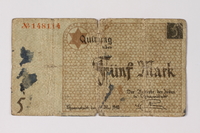
Łódź (Litzmannstadt) ghetto scrip, 5 mark note
Object
5 (funf) mark receipt issued in the Łódź ghetto in Poland beginning in May 1940 until the ghetto was liquidated in summer 1944. Nazi Germany invaded Poland on September 1, 1939, and occupied Łódź one week later. Łódź was renamed Litzmannstadt and, by February 1940, the Germans forcibly relocated the large Jewish population of 160,000 into a small, sealed ghetto. All residents had to work and many were forced laborers in ghetto factories. Residents were forbidden to have German currency, and the Jewish Council was ordered to create a system of Quittungen [receipts] that could be used only in the ghetto. The scrip, sometimes referred to as rumkis, after the Elder of the Judenrat, Mordechai Rumkowski, was issued in 7 denominations: 50 pfenning, 1, 2, 5, 10, 20, and 50 marks, as well as coins. It acted as a labor incentive and facilitated the confiscation of money and goods from internees. There was little to exchange it for in the ghetto. Living conditions were horrendous; the severe overcrowding and lack of food made disease and starvation common. In January 1942, mass deportations to Chelmno killing center began; half the residents were murdered by the end of the year. In summer 1944, Łódź, the last ghetto in Poland, was destroyed and the remaining Jews were sent to Chelmno and Auschwitz-Birkenau killing centers.
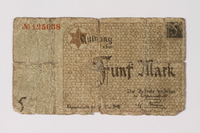
Łódź (Litzmannstadt) ghetto scrip, 5 mark note
Object
5 (funf) mark receipt issued in the Łódź ghetto in Poland beginning in May 1940 until the ghetto was liquidated in summer 1944. Nazi Germany invaded Poland on September 1, 1939, and occupied Łódź one week later. Łódź was renamed Litzmannstadt and, by February 1940, the Germans forcibly relocated the large Jewish population of 160,000 into a small, sealed ghetto. All residents had to work and many were forced laborers in ghetto factories. Residents were forbidden to have German currency, and the Jewish Council was ordered to create a system of Quittungen [receipts] that could be used only in the ghetto. The scrip, sometimes referred to as rumkis, after the Elder of the Judenrat, Mordechai Rumkowski, was issued in 7 denominations: 50 pfenning, 1, 2, 5, 10, 20, and 50 marks, as well as coins. It acted as a labor incentive and facilitated the confiscation of money and goods from internees. There was little to exchange it for in the ghetto. Living conditions were horrendous; the severe overcrowding and lack of food made disease and starvation common. In January 1942, mass deportations to Chelmno killing center began; half the residents were murdered by the end of the year. In summer 1944, Łódź, the last ghetto in Poland, was destroyed and the remaining Jews were sent to Chelmno and Auschwitz-Birkenau killing centers.
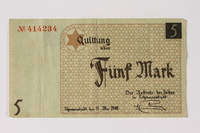
Łódź (Litzmannstadt) ghetto scrip, 5 mark note
Object
5 (funf) mark receipt issued in the Łódź ghetto in Poland beginning in May 1940 until the ghetto was liquidated in summer 1944. Nazi Germany invaded Poland on September 1, 1939, and occupied Łódź one week later. Łódź was renamed Litzmannstadt and, by February 1940, the Germans forcibly relocated the large Jewish population of 160,000 into a small, sealed ghetto. All residents had to work and many were forced laborers in ghetto factories. Residents were forbidden to have German currency, and the Jewish Council was ordered to create a system of Quittungen [receipts] that could be used only in the ghetto. The scrip, sometimes referred to as rumkis, after the Elder of the Judenrat, Mordechai Rumkowski, was issued in 7 denominations: 50 pfenning, 1, 2, 5, 10, 20, and 50 marks, as well as coins. It acted as a labor incentive and facilitated the confiscation of money and goods from internees. There was little to exchange it for in the ghetto. Living conditions were horrendous; the severe overcrowding and lack of food made disease and starvation common. In January 1942, mass deportations to Chelmno killing center began; half the residents were murdered by the end of the year. In summer 1944, Łódź, the last ghetto in Poland, was destroyed and the remaining Jews were sent to Chelmno and Auschwitz-Birkenau killing centers.
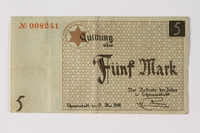
Łódź (Litzmannstadt) ghetto scrip, 5 mark note
Object
5 (funf) mark receipt issued in the Łódź ghetto in Poland beginning in May 1940 until the ghetto was liquidated in summer 1944. Nazi Germany invaded Poland on September 1, 1939, and occupied Łódź one week later. Łódź was renamed Litzmannstadt and, by February 1940, the Germans forcibly relocated the large Jewish population of 160,000 into a small, sealed ghetto. All residents had to work and many were forced laborers in ghetto factories. Residents were forbidden to have German currency, and the Jewish Council was ordered to create a system of Quittungen [receipts] that could be used only in the ghetto. The scrip, sometimes referred to as rumkis, after the Elder of the Judenrat, Mordechai Rumkowski, was issued in 7 denominations: 50 pfenning, 1, 2, 5, 10, 20, and 50 marks, as well as coins. It acted as a labor incentive and facilitated the confiscation of money and goods from internees. There was little to exchange it for in the ghetto. Living conditions were horrendous; the severe overcrowding and lack of food made disease and starvation common. In January 1942, mass deportations to Chelmno killing center began; half the residents were murdered by the end of the year. In summer 1944, Łódź, the last ghetto in Poland, was destroyed and the remaining Jews were sent to Chelmno and Auschwitz-Birkenau killing centers.
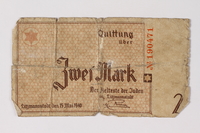
Łódź (Litzmannstadt) ghetto scrip, 2 mark note
Object
2 [zwei] mark receipt issued in the Łódź ghetto in Poland beginning in May 1940 until the ghetto was liquidated in summer 1944. Nazi Germany invaded Poland on September 1, 1939, and occupied Łódź one week later. Łódź was renamed Litzmannstadt and, by February 1940, the Germans forcibly relocated the large Jewish population of 160,000 into a small, sealed ghetto. All residents had to work and many were forced laborers in ghetto factories. Residents were forbidden to have German currency, and the Jewish Council was ordered to create a system of Quittungen [receipts] that could be used only in the ghetto. The scrip, sometimes referred to as rumkis, after the Elder of the Judenrat, Mordechai Rumkowski, was issued in 7 denominations: 50 pfenning, 1, 2, 5, 10, 20, 50, and 100 marks, as well as coins. It acted as a labor incentive and facilitated the confiscation of money and goods from internees. There was little to exchange it for in the ghetto. Living conditions were horrendous; the severe overcrowding and lack of food made disease and starvation common. In January 1942, mass deportations to Chelmno killing center began; half the residents were murdered by the end of the year. In summer 1944, Łódź, the last ghetto in Poland, was destroyed and the remaining Jews were sent to Chelmno and Auschwitz-Birkenau killing centers.
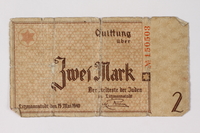
Łódź (Litzmannstadt) ghetto scrip, 2 mark note
Object
2 [zwei] mark receipt issued in the Łódź ghetto in Poland beginning in May 1940 until the ghetto was liquidated in summer 1944. Nazi Germany invaded Poland on September 1, 1939, and occupied Łódź one week later. Łódź was renamed Litzmannstadt and, by February 1940, the Germans forcibly relocated the large Jewish population of 160,000 into a small, sealed ghetto. All residents had to work and many were forced laborers in ghetto factories. Residents were forbidden to have German currency, and the Jewish Council was ordered to create a system of Quittungen [receipts] that could be used only in the ghetto. The scrip, sometimes referred to as rumkis, after the Elder of the Judenrat, Mordechai Rumkowski, was issued in 7 denominations: 50 pfenning, 1, 2, 5, 10, 20, 50, and 100 marks, as well as coins. It acted as a labor incentive and facilitated the confiscation of money and goods from internees. There was little to exchange it for in the ghetto. Living conditions were horrendous; the severe overcrowding and lack of food made disease and starvation common. In January 1942, mass deportations to Chelmno killing center began; half the residents were murdered by the end of the year. In summer 1944, Łódź, the last ghetto in Poland, was destroyed and the remaining Jews were sent to Chelmno and Auschwitz-Birkenau killing centers.
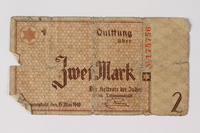
Łódź (Litzmannstadt) ghetto scrip, 2 mark note
Object
2 [zwei] mark receipt issued in the Łódź ghetto in Poland beginning in May 1940 until the ghetto was liquidated in summer 1944. Nazi Germany invaded Poland on September 1, 1939, and occupied Łódź one week later. Łódź was renamed Litzmannstadt and, by February 1940, the Germans forcibly relocated the large Jewish population of 160,000 into a small, sealed ghetto. All residents had to work and many were forced laborers in ghetto factories. Residents were forbidden to have German currency, and the Jewish Council was ordered to create a system of Quittungen [receipts] that could be used only in the ghetto. The scrip, sometimes referred to as rumkis, after the Elder of the Judenrat, Mordechai Rumkowski, was issued in 7 denominations: 50 pfenning, 1, 2, 5, 10, 20, 50, and 100 marks, as well as coins. It acted as a labor incentive and facilitated the confiscation of money and goods from internees. There was little to exchange it for in the ghetto. Living conditions were horrendous; the severe overcrowding and lack of food made disease and starvation common. In January 1942, mass deportations to Chelmno killing center began; half the residents were murdered by the end of the year. In summer 1944, Łódź, the last ghetto in Poland, was destroyed and the remaining Jews were sent to Chelmno and Auschwitz-Birkenau killing centers.
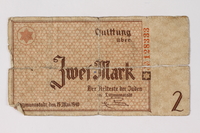
Łódź (Litzmannstadt) ghetto scrip, 2 mark note
Object
2 [zwei] mark receipt issued in the Łódź ghetto in Poland beginning in May 1940 until the ghetto was liquidated in summer 1944. Nazi Germany invaded Poland on September 1, 1939, and occupied Łódź one week later. Łódź was renamed Litzmannstadt and, by February 1940, the Germans forcibly relocated the large Jewish population of 160,000 into a small, sealed ghetto. All residents had to work and many were forced laborers in ghetto factories. Residents were forbidden to have German currency, and the Jewish Council was ordered to create a system of Quittungen [receipts] that could be used only in the ghetto. The scrip, sometimes referred to as rumkis, after the Elder of the Judenrat, Mordechai Rumkowski, was issued in 7 denominations: 50 pfenning, 1, 2, 5, 10, 20, 50, and 100 marks, as well as coins. It acted as a labor incentive and facilitated the confiscation of money and goods from internees. There was little to exchange it for in the ghetto. Living conditions were horrendous; the severe overcrowding and lack of food made disease and starvation common. In January 1942, mass deportations to Chelmno killing center began; half the residents were murdered by the end of the year. In summer 1944, Łódź, the last ghetto in Poland, was destroyed and the remaining Jews were sent to Chelmno and Auschwitz-Birkenau killing centers.
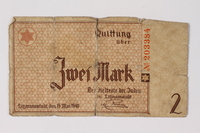
Łódź (Litzmannstadt) ghetto scrip, 2 mark note
Object
2 [zwei] mark receipt issued in the Łódź ghetto in Poland beginning in May 1940 until the ghetto was liquidated in summer 1944. Nazi Germany invaded Poland on September 1, 1939, and occupied Łódź one week later. Łódź was renamed Litzmannstadt and, by February 1940, the Germans forcibly relocated the large Jewish population of 160,000 into a small, sealed ghetto. All residents had to work and many were forced laborers in ghetto factories. Residents were forbidden to have German currency, and the Jewish Council was ordered to create a system of Quittungen [receipts] that could be used only in the ghetto. The scrip, sometimes referred to as rumkis, after the Elder of the Judenrat, Mordechai Rumkowski, was issued in 7 denominations: 50 pfenning, 1, 2, 5, 10, 20, 50, and 100 marks, as well as coins. It acted as a labor incentive and facilitated the confiscation of money and goods from internees. There was little to exchange it for in the ghetto. Living conditions were horrendous; the severe overcrowding and lack of food made disease and starvation common. In January 1942, mass deportations to Chelmno killing center began; half the residents were murdered by the end of the year. In summer 1944, Łódź, the last ghetto in Poland, was destroyed and the remaining Jews were sent to Chelmno and Auschwitz-Birkenau killing centers.

Łódź (Litzmannstadt) ghetto scrip, 2 mark note
Object
2 [zwei] mark receipt issued in the Łódź ghetto in Poland beginning in May 1940 until the ghetto was liquidated in summer 1944. Nazi Germany invaded Poland on September 1, 1939, and occupied Łódź one week later. Łódź was renamed Litzmannstadt and, by February 1940, the Germans forcibly relocated the large Jewish population of 160,000 into a small, sealed ghetto. All residents had to work and many were forced laborers in ghetto factories. Residents were forbidden to have German currency, and the Jewish Council was ordered to create a system of Quittungen [receipts] that could be used only in the ghetto. The scrip, sometimes referred to as rumkis, after the Elder of the Judenrat, Mordechai Rumkowski, was issued in 7 denominations: 50 pfenning, 1, 2, 5, 10, 20, 50, and 100 marks, as well as coins. It acted as a labor incentive and facilitated the confiscation of money and goods from internees. There was little to exchange it for in the ghetto. Living conditions were horrendous; the severe overcrowding and lack of food made disease and starvation common. In January 1942, mass deportations to Chelmno killing center began; half the residents were murdered by the end of the year. In summer 1944, Łódź, the last ghetto in Poland, was destroyed and the remaining Jews were sent to Chelmno and Auschwitz-Birkenau killing centers.
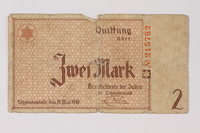
Łódź (Litzmannstadt) ghetto scrip, 2 mark note
Object
2 [zwei] mark receipt issued in the Łódź ghetto in Poland beginning in May 1940 until the ghetto was liquidated in summer 1944. Nazi Germany invaded Poland on September 1, 1939, and occupied Łódź one week later. Łódź was renamed Litzmannstadt and, by February 1940, the Germans forcibly relocated the large Jewish population of 160,000 into a small, sealed ghetto. All residents had to work and many were forced laborers in ghetto factories. Residents were forbidden to have German currency, and the Jewish Council was ordered to create a system of Quittungen [receipts] that could be used only in the ghetto. The scrip, sometimes referred to as rumkis, after the Elder of the Judenrat, Mordechai Rumkowski, was issued in 7 denominations: 50 pfenning, 1, 2, 5, 10, 20, 50, and 100 marks, as well as coins. It acted as a labor incentive and facilitated the confiscation of money and goods from internees. There was little to exchange it for in the ghetto. Living conditions were horrendous; the severe overcrowding and lack of food made disease and starvation common. In January 1942, mass deportations to Chelmno killing center began; half the residents were murdered by the end of the year. In summer 1944, Łódź, the last ghetto in Poland, was destroyed and the remaining Jews were sent to Chelmno and Auschwitz-Birkenau killing centers.

Łódź (Litzmannstadt) ghetto scrip, 2 mark note
Object
2 [zwei] mark receipt issued in the Łódź ghetto in Poland beginning in May 1940 until the ghetto was liquidated in summer 1944. Nazi Germany invaded Poland on September 1, 1939, and occupied Łódź one week later. Łódź was renamed Litzmannstadt and, by February 1940, the Germans forcibly relocated the large Jewish population of 160,000 into a small, sealed ghetto. All residents had to work and many were forced laborers in ghetto factories. Residents were forbidden to have German currency, and the Jewish Council was ordered to create a system of Quittungen [receipts] that could be used only in the ghetto. The scrip, sometimes referred to as rumkis, after the Elder of the Judenrat, Mordechai Rumkowski, was issued in 7 denominations: 50 pfenning, 1, 2, 5, 10, 20, 50, and 100 marks, as well as coins. It acted as a labor incentive and facilitated the confiscation of money and goods from internees. There was little to exchange it for in the ghetto. Living conditions were horrendous; the severe overcrowding and lack of food made disease and starvation common. In January 1942, mass deportations to Chelmno killing center began; half the residents were murdered by the end of the year. In summer 1944, Łódź, the last ghetto in Poland, was destroyed and the remaining Jews were sent to Chelmno and Auschwitz-Birkenau killing centers.
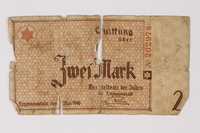
Łódź (Litzmannstadt) ghetto scrip, 2 mark note
Object
2 [zwei] mark receipt issued in the Łódź ghetto in Poland beginning in May 1940 until the ghetto was liquidated in summer 1944. Nazi Germany invaded Poland on September 1, 1939, and occupied Łódź one week later. Łódź was renamed Litzmannstadt and, by February 1940, the Germans forcibly relocated the large Jewish population of 160,000 into a small, sealed ghetto. All residents had to work and many were forced laborers in ghetto factories. Residents were forbidden to have German currency, and the Jewish Council was ordered to create a system of Quittungen [receipts] that could be used only in the ghetto. The scrip, sometimes referred to as rumkis, after the Elder of the Judenrat, Mordechai Rumkowski, was issued in 7 denominations: 50 pfenning, 1, 2, 5, 10, 20, 50, and 100 marks, as well as coins. It acted as a labor incentive and facilitated the confiscation of money and goods from internees. There was little to exchange it for in the ghetto. Living conditions were horrendous; the severe overcrowding and lack of food made disease and starvation common. In January 1942, mass deportations to Chelmno killing center began; half the residents were murdered by the end of the year. In summer 1944, Łódź, the last ghetto in Poland, was destroyed and the remaining Jews were sent to Chelmno and Auschwitz-Birkenau killing centers.
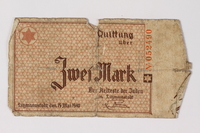
Łódź (Litzmannstadt) ghetto scrip, 2 mark note
Object
2 [zwei] mark receipt issued in the Łódź ghetto in Poland beginning in May 1940 until the ghetto was liquidated in summer 1944. Nazi Germany invaded Poland on September 1, 1939, and occupied Łódź one week later. Łódź was renamed Litzmannstadt and, by February 1940, the Germans forcibly relocated the large Jewish population of 160,000 into a small, sealed ghetto. All residents had to work and many were forced laborers in ghetto factories. Residents were forbidden to have German currency, and the Jewish Council was ordered to create a system of Quittungen [receipts] that could be used only in the ghetto. The scrip, sometimes referred to as rumkis, after the Elder of the Judenrat, Mordechai Rumkowski, was issued in 7 denominations: 50 pfenning, 1, 2, 5, 10, 20, 50, and 100 marks, as well as coins. It acted as a labor incentive and facilitated the confiscation of money and goods from internees. There was little to exchange it for in the ghetto. Living conditions were horrendous; the severe overcrowding and lack of food made disease and starvation common. In January 1942, mass deportations to Chelmno killing center began; half the residents were murdered by the end of the year. In summer 1944, Łódź, the last ghetto in Poland, was destroyed and the remaining Jews were sent to Chelmno and Auschwitz-Birkenau killing centers.
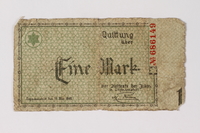
Łódź (Litzmannstadt) ghetto scrip, 1 mark note
Object
1 [eine] mark receipt issued in the Łódź ghetto in Poland beginning in May 1940 until the ghetto was liquidated in summer 1944. Nazi Germany invaded Poland on September 1, 1939, and occupied Łódź one week later. Łódź was renamed Litzmannstadt and, by February 1940, the Germans forcibly relocated the large Jewish population of 160,000 into a small, sealed ghetto. All residents had to work and many were forced laborers in ghetto factories. Residents were forbidden to have German currency, and the Jewish Council was ordered to create a system of Quittungen [receipts] that could be used only in the ghetto. The scrip, sometimes referred to as rumkis, after the Elder of the Judenrat, Mordechai Rumkowski, was issued in 7 denominations: 50 pfenning, 1, 2, 5, 10, 20, 50, and 100 marks, as well as coins. It acted as a labor incentive and facilitated the confiscation of money and goods from internees. There was little to exchange it for in the ghetto. Living conditions were horrendous; the severe overcrowding and lack of food made disease and starvation common. In January 1942, mass deportations to Chelmno killing center began; half the residents were murdered by the end of the year. In summer 1944, Łódź, the last ghetto in Poland, was destroyed and the remaining Jews were sent to Chelmno and Auschwitz-Birkenau killing centers.
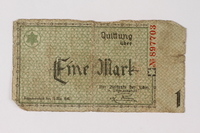
Łódź (Litzmannstadt) ghetto scrip, 1 mark note
Object
1 [eine] mark receipt issued in the Łódź ghetto in Poland beginning in May 1940 until the ghetto was liquidated in summer 1944. Nazi Germany invaded Poland on September 1, 1939, and occupied Łódź one week later. Łódź was renamed Litzmannstadt and, by February 1940, the Germans forcibly relocated the large Jewish population of 160,000 into a small, sealed ghetto. All residents had to work and many were forced laborers in ghetto factories. Residents were forbidden to have German currency, and the Jewish Council was ordered to create a system of Quittungen [receipts] that could be used only in the ghetto. The scrip, sometimes referred to as rumkis, after the Elder of the Judenrat, Mordechai Rumkowski, was issued in 7 denominations: 50 pfenning, 1, 2, 5, 10, 20, 50, and 100 marks, as well as coins. It acted as a labor incentive and facilitated the confiscation of money and goods from internees. There was little to exchange it for in the ghetto. Living conditions were horrendous; the severe overcrowding and lack of food made disease and starvation common. In January 1942, mass deportations to Chelmno killing center began; half the residents were murdered by the end of the year. In summer 1944, Łódź, the last ghetto in Poland, was destroyed and the remaining Jews were sent to Chelmno and Auschwitz-Birkenau killing centers.

Łódź (Litzmannstadt) ghetto scrip, 1 mark note
Object
1 [eine] mark receipt issued in the Łódź ghetto in Poland beginning in May 1940 until the ghetto was liquidated in summer 1944. Nazi Germany invaded Poland on September 1, 1939, and occupied Łódź one week later. Łódź was renamed Litzmannstadt and, by February 1940, the Germans forcibly relocated the large Jewish population of 160,000 into a small, sealed ghetto. All residents had to work and many were forced laborers in ghetto factories. Residents were forbidden to have German currency, and the Jewish Council was ordered to create a system of Quittungen [receipts] that could be used only in the ghetto. The scrip, sometimes referred to as rumkis, after the Elder of the Judenrat, Mordechai Rumkowski, was issued in 7 denominations: 50 pfenning, 1, 2, 5, 10, 20, 50, and 100 marks, as well as coins. It acted as a labor incentive and facilitated the confiscation of money and goods from internees. There was little to exchange it for in the ghetto. Living conditions were horrendous; the severe overcrowding and lack of food made disease and starvation common. In January 1942, mass deportations to Chelmno killing center began; half the residents were murdered by the end of the year. In summer 1944, Łódź, the last ghetto in Poland, was destroyed and the remaining Jews were sent to Chelmno and Auschwitz-Birkenau killing centers.

Łódź (Litzmannstadt) ghetto scrip, 1 mark note
Object
1 [eine] mark receipt issued in the Łódź ghetto in Poland beginning in May 1940 until the ghetto was liquidated in summer 1944. Nazi Germany invaded Poland on September 1, 1939, and occupied Łódź one week later. Łódź was renamed Litzmannstadt and, by February 1940, the Germans forcibly relocated the large Jewish population of 160,000 into a small, sealed ghetto. All residents had to work and many were forced laborers in ghetto factories. Residents were forbidden to have German currency, and the Jewish Council was ordered to create a system of Quittungen [receipts] that could be used only in the ghetto. The scrip, sometimes referred to as rumkis, after the Elder of the Judenrat, Mordechai Rumkowski, was issued in 7 denominations: 50 pfenning, 1, 2, 5, 10, 20, 50, and 100 marks, as well as coins. It acted as a labor incentive and facilitated the confiscation of money and goods from internees. There was little to exchange it for in the ghetto. Living conditions were horrendous; the severe overcrowding and lack of food made disease and starvation common. In January 1942, mass deportations to Chelmno killing center began; half the residents were murdered by the end of the year. In summer 1944, Łódź, the last ghetto in Poland, was destroyed and the remaining Jews were sent to Chelmno and Auschwitz-Birkenau killing centers.
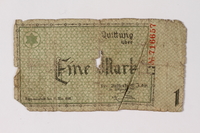
Łódź (Litzmannstadt) ghetto scrip, 1 mark note
Object
1 [eine] mark receipt issued in the Łódź ghetto in Poland beginning in May 1940 until the ghetto was liquidated in summer 1944. Nazi Germany invaded Poland on September 1, 1939, and occupied Łódź one week later. Łódź was renamed Litzmannstadt and, by February 1940, the Germans forcibly relocated the large Jewish population of 160,000 into a small, sealed ghetto. All residents had to work and many were forced laborers in ghetto factories. Residents were forbidden to have German currency, and the Jewish Council was ordered to create a system of Quittungen [receipts] that could be used only in the ghetto. The scrip, sometimes referred to as rumkis, after the Elder of the Judenrat, Mordechai Rumkowski, was issued in 7 denominations: 50 pfenning, 1, 2, 5, 10, 20, 50, and 100 marks, as well as coins. It acted as a labor incentive and facilitated the confiscation of money and goods from internees. There was little to exchange it for in the ghetto. Living conditions were horrendous; the severe overcrowding and lack of food made disease and starvation common. In January 1942, mass deportations to Chelmno killing center began; half the residents were murdered by the end of the year. In summer 1944, Łódź, the last ghetto in Poland, was destroyed and the remaining Jews were sent to Chelmno and Auschwitz-Birkenau killing centers.

Łódź (Litzmannstadt) ghetto scrip, 1 mark note
Object
1 [eine] mark receipt issued in the Łódź ghetto in Poland beginning in May 1940 until the ghetto was liquidated in summer 1944. Nazi Germany invaded Poland on September 1, 1939, and occupied Łódź one week later. Łódź was renamed Litzmannstadt and, by February 1940, the Germans forcibly relocated the large Jewish population of 160,000 into a small, sealed ghetto. All residents had to work and many were forced laborers in ghetto factories. Residents were forbidden to have German currency, and the Jewish Council was ordered to create a system of Quittungen [receipts] that could be used only in the ghetto. The scrip, sometimes referred to as rumkis, after the Elder of the Judenrat, Mordechai Rumkowski, was issued in 7 denominations: 50 pfenning, 1, 2, 5, 10, 20, 50, and 100 marks, as well as coins. It acted as a labor incentive and facilitated the confiscation of money and goods from internees. There was little to exchange it for in the ghetto. Living conditions were horrendous; the severe overcrowding and lack of food made disease and starvation common. In January 1942, mass deportations to Chelmno killing center began; half the residents were murdered by the end of the year. In summer 1944, Łódź, the last ghetto in Poland, was destroyed and the remaining Jews were sent to Chelmno and Auschwitz-Birkenau killing centers.

Łódź (Litzmannstadt) ghetto scrip, 1 mark note
Object
1 [eine] mark receipt issued in the Łódź ghetto in Poland beginning in May 1940 until the ghetto was liquidated in summer 1944. Nazi Germany invaded Poland on September 1, 1939, and occupied Łódź one week later. Łódź was renamed Litzmannstadt and, by February 1940, the Germans forcibly relocated the large Jewish population of 160,000 into a small, sealed ghetto. All residents had to work and many were forced laborers in ghetto factories. Residents were forbidden to have German currency, and the Jewish Council was ordered to create a system of Quittungen [receipts] that could be used only in the ghetto. The scrip, sometimes referred to as rumkis, after the Elder of the Judenrat, Mordechai Rumkowski, was issued in 7 denominations: 50 pfenning, 1, 2, 5, 10, 20, 50, and 100 marks, as well as coins. It acted as a labor incentive and facilitated the confiscation of money and goods from internees. There was little to exchange it for in the ghetto. Living conditions were horrendous; the severe overcrowding and lack of food made disease and starvation common. In January 1942, mass deportations to Chelmno killing center began; half the residents were murdered by the end of the year. In summer 1944, Łódź, the last ghetto in Poland, was destroyed and the remaining Jews were sent to Chelmno and Auschwitz-Birkenau killing centers.
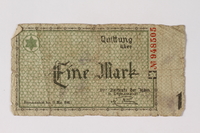
Łódź (Litzmannstadt) ghetto scrip, 1 mark note
Object
1 [eine] mark receipt issued in the Łódź ghetto in Poland beginning in May 1940 until the ghetto was liquidated in summer 1944. Nazi Germany invaded Poland on September 1, 1939, and occupied Łódź one week later. Łódź was renamed Litzmannstadt and, by February 1940, the Germans forcibly relocated the large Jewish population of 160,000 into a small, sealed ghetto. All residents had to work and many were forced laborers in ghetto factories. Residents were forbidden to have German currency, and the Jewish Council was ordered to create a system of Quittungen [receipts] that could be used only in the ghetto. The scrip, sometimes referred to as rumkis, after the Elder of the Judenrat, Mordechai Rumkowski, was issued in 7 denominations: 50 pfenning, 1, 2, 5, 10, 20, 50, and 100 marks, as well as coins. It acted as a labor incentive and facilitated the confiscation of money and goods from internees. There was little to exchange it for in the ghetto. Living conditions were horrendous; the severe overcrowding and lack of food made disease and starvation common. In January 1942, mass deportations to Chelmno killing center began; half the residents were murdered by the end of the year. In summer 1944, Łódź, the last ghetto in Poland, was destroyed and the remaining Jews were sent to Chelmno and Auschwitz-Birkenau killing centers.
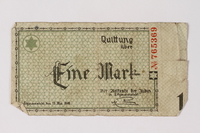
Łódź (Litzmannstadt) ghetto scrip, 1 mark note
Object
1 [eine] mark receipt issued in the Łódź ghetto in Poland beginning in May 1940 until the ghetto was liquidated in summer 1944. Nazi Germany invaded Poland on September 1, 1939, and occupied Łódź one week later. Łódź was renamed Litzmannstadt and, by February 1940, the Germans forcibly relocated the large Jewish population of 160,000 into a small, sealed ghetto. All residents had to work and many were forced laborers in ghetto factories. Residents were forbidden to have German currency, and the Jewish Council was ordered to create a system of Quittungen [receipts] that could be used only in the ghetto. The scrip, sometimes referred to as rumkis, after the Elder of the Judenrat, Mordechai Rumkowski, was issued in 7 denominations: 50 pfenning, 1, 2, 5, 10, 20, 50, and 100 marks, as well as coins. It acted as a labor incentive and facilitated the confiscation of money and goods from internees. There was little to exchange it for in the ghetto. Living conditions were horrendous; the severe overcrowding and lack of food made disease and starvation common. In January 1942, mass deportations to Chelmno killing center began; half the residents were murdered by the end of the year. In summer 1944, Łódź, the last ghetto in Poland, was destroyed and the remaining Jews were sent to Chelmno and Auschwitz-Birkenau killing centers.
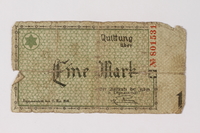
Łódź (Litzmannstadt) ghetto scrip, 1 mark note
Object
1 [eine] mark receipt issued in the Łódź ghetto in Poland beginning in May 1940 until the ghetto was liquidated in summer 1944. Nazi Germany invaded Poland on September 1, 1939, and occupied Łódź one week later. Łódź was renamed Litzmannstadt and, by February 1940, the Germans forcibly relocated the large Jewish population of 160,000 into a small, sealed ghetto. All residents had to work and many were forced laborers in ghetto factories. Residents were forbidden to have German currency, and the Jewish Council was ordered to create a system of Quittungen [receipts] that could be used only in the ghetto. The scrip, sometimes referred to as rumkis, after the Elder of the Judenrat, Mordechai Rumkowski, was issued in 7 denominations: 50 pfenning, 1, 2, 5, 10, 20, 50, and 100 marks, as well as coins. It acted as a labor incentive and facilitated the confiscation of money and goods from internees. There was little to exchange it for in the ghetto. Living conditions were horrendous; the severe overcrowding and lack of food made disease and starvation common. In January 1942, mass deportations to Chelmno killing center began; half the residents were murdered by the end of the year. In summer 1944, Łódź, the last ghetto in Poland, was destroyed and the remaining Jews were sent to Chelmno and Auschwitz-Birkenau killing centers.
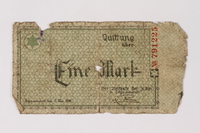
Łódź (Litzmannstadt) ghetto scrip, 1 mark note
Object
1 [eine] mark receipt issued in the Łódź ghetto in Poland beginning in May 1940 until the ghetto was liquidated in summer 1944. Nazi Germany invaded Poland on September 1, 1939, and occupied Łódź one week later. Łódź was renamed Litzmannstadt and, by February 1940, the Germans forcibly relocated the large Jewish population of 160,000 into a small, sealed ghetto. All residents had to work and many were forced laborers in ghetto factories. Residents were forbidden to have German currency, and the Jewish Council was ordered to create a system of Quittungen [receipts] that could be used only in the ghetto. The scrip, sometimes referred to as rumkis, after the Elder of the Judenrat, Mordechai Rumkowski, was issued in 7 denominations: 50 pfenning, 1, 2, 5, 10, 20, 50, and 100 marks, as well as coins. It acted as a labor incentive and facilitated the confiscation of money and goods from internees. There was little to exchange it for in the ghetto. Living conditions were horrendous; the severe overcrowding and lack of food made disease and starvation common. In January 1942, mass deportations to Chelmno killing center began; half the residents were murdered by the end of the year. In summer 1944, Łódź, the last ghetto in Poland, was destroyed and the remaining Jews were sent to Chelmno and Auschwitz-Birkenau killing centers.
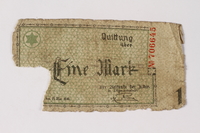
Łódź (Litzmannstadt) ghetto scrip, 1 mark note
Object
1 [eine] mark receipt issued in the Łódź ghetto in Poland beginning in May 1940 until the ghetto was liquidated in summer 1944. Nazi Germany invaded Poland on September 1, 1939, and occupied Łódź one week later. Łódź was renamed Litzmannstadt and, by February 1940, the Germans forcibly relocated the large Jewish population of 160,000 into a small, sealed ghetto. All residents had to work and many were forced laborers in ghetto factories. Residents were forbidden to have German currency, and the Jewish Council was ordered to create a system of Quittungen [receipts] that could be used only in the ghetto. The scrip, sometimes referred to as rumkis, after the Elder of the Judenrat, Mordechai Rumkowski, was issued in 7 denominations: 50 pfenning, 1, 2, 5, 10, 20, 50, and 100 marks, as well as coins. It acted as a labor incentive and facilitated the confiscation of money and goods from internees. There was little to exchange it for in the ghetto. Living conditions were horrendous; the severe overcrowding and lack of food made disease and starvation common. In January 1942, mass deportations to Chelmno killing center began; half the residents were murdered by the end of the year. In summer 1944, Łódź, the last ghetto in Poland, was destroyed and the remaining Jews were sent to Chelmno and Auschwitz-Birkenau killing centers.
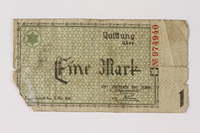
Łódź (Litzmannstadt) ghetto scrip, 1 mark note
Object
1 [eine] mark receipt issued in the Łódź ghetto in Poland beginning in May 1940 until the ghetto was liquidated in summer 1944. Nazi Germany invaded Poland on September 1, 1939, and occupied Łódź one week later. Łódź was renamed Litzmannstadt and, by February 1940, the Germans forcibly relocated the large Jewish population of 160,000 into a small, sealed ghetto. All residents had to work and many were forced laborers in ghetto factories. Residents were forbidden to have German currency, and the Jewish Council was ordered to create a system of Quittungen [receipts] that could be used only in the ghetto. The scrip, sometimes referred to as rumkis, after the Elder of the Judenrat, Mordechai Rumkowski, was issued in 7 denominations: 50 pfenning, 1, 2, 5, 10, 20, 50, and 100 marks, as well as coins. It acted as a labor incentive and facilitated the confiscation of money and goods from internees. There was little to exchange it for in the ghetto. Living conditions were horrendous; the severe overcrowding and lack of food made disease and starvation common. In January 1942, mass deportations to Chelmno killing center began; half the residents were murdered by the end of the year. In summer 1944, Łódź, the last ghetto in Poland, was destroyed and the remaining Jews were sent to Chelmno and Auschwitz-Birkenau killing centers.
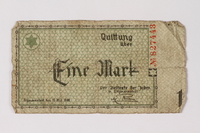
Łódź (Litzmannstadt) ghetto scrip, 1 mark note
Object
1 [eine] mark receipt issued in the Łódź ghetto in Poland beginning in May 1940 until the ghetto was liquidated in summer 1944. Nazi Germany invaded Poland on September 1, 1939, and occupied Łódź one week later. Łódź was renamed Litzmannstadt and, by February 1940, the Germans forcibly relocated the large Jewish population of 160,000 into a small, sealed ghetto. All residents had to work and many were forced laborers in ghetto factories. Residents were forbidden to have German currency, and the Jewish Council was ordered to create a system of Quittungen [receipts] that could be used only in the ghetto. The scrip, sometimes referred to as rumkis, after the Elder of the Judenrat, Mordechai Rumkowski, was issued in 7 denominations: 50 pfenning, 1, 2, 5, 10, 20, 50, and 100 marks, as well as coins. It acted as a labor incentive and facilitated the confiscation of money and goods from internees. There was little to exchange it for in the ghetto. Living conditions were horrendous; the severe overcrowding and lack of food made disease and starvation common. In January 1942, mass deportations to Chelmno killing center began; half the residents were murdered by the end of the year. In summer 1944, Łódź, the last ghetto in Poland, was destroyed and the remaining Jews were sent to Chelmno and Auschwitz-Birkenau killing centers.
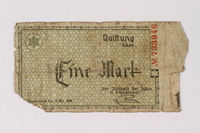
Łódź (Litzmannstadt) ghetto scrip, 1 mark note
Object
1 [eine] mark receipt issued in the Łódź ghetto in Poland beginning in May 1940 until the ghetto was liquidated in summer 1944. Nazi Germany invaded Poland on September 1, 1939, and occupied Łódź one week later. Łódź was renamed Litzmannstadt and, by February 1940, the Germans forcibly relocated the large Jewish population of 160,000 into a small, sealed ghetto. All residents had to work and many were forced laborers in ghetto factories. Residents were forbidden to have German currency, and the Jewish Council was ordered to create a system of Quittungen [receipts] that could be used only in the ghetto. The scrip, sometimes referred to as rumkis, after the Elder of the Judenrat, Mordechai Rumkowski, was issued in 7 denominations: 50 pfenning, 1, 2, 5, 10, 20, 50, and 100 marks, as well as coins. It acted as a labor incentive and facilitated the confiscation of money and goods from internees. There was little to exchange it for in the ghetto. Living conditions were horrendous; the severe overcrowding and lack of food made disease and starvation common. In January 1942, mass deportations to Chelmno killing center began; half the residents were murdered by the end of the year. In summer 1944, Łódź, the last ghetto in Poland, was destroyed and the remaining Jews were sent to Chelmno and Auschwitz-Birkenau killing centers.

Łódź (Litzmannstadt) ghetto scrip, 1 mark note
Object
1 [eine] mark receipt issued in the Łódź ghetto in Poland beginning in May 1940 until the ghetto was liquidated in summer 1944. Nazi Germany invaded Poland on September 1, 1939, and occupied Łódź one week later. Łódź was renamed Litzmannstadt and, by February 1940, the Germans forcibly relocated the large Jewish population of 160,000 into a small, sealed ghetto. All residents had to work and many were forced laborers in ghetto factories. Residents were forbidden to have German currency, and the Jewish Council was ordered to create a system of Quittungen [receipts] that could be used only in the ghetto. The scrip, sometimes referred to as rumkis, after the Elder of the Judenrat, Mordechai Rumkowski, was issued in 7 denominations: 50 pfenning, 1, 2, 5, 10, 20, 50, and 100 marks, as well as coins. It acted as a labor incentive and facilitated the confiscation of money and goods from internees. There was little to exchange it for in the ghetto. Living conditions were horrendous; the severe overcrowding and lack of food made disease and starvation common. In January 1942, mass deportations to Chelmno killing center began; half the residents were murdered by the end of the year. In summer 1944, Łódź, the last ghetto in Poland, was destroyed and the remaining Jews were sent to Chelmno and Auschwitz-Birkenau killing centers.
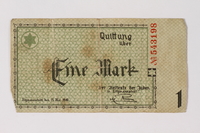
Łódź (Litzmannstadt) ghetto scrip, 1 mark note
Object
1 [eine] mark receipt issued in the Łódź ghetto in Poland beginning in May 1940 until the ghetto was liquidated in summer 1944. Nazi Germany invaded Poland on September 1, 1939, and occupied Łódź one week later. Łódź was renamed Litzmannstadt and, by February 1940, the Germans forcibly relocated the large Jewish population of 160,000 into a small, sealed ghetto. All residents had to work and many were forced laborers in ghetto factories. Residents were forbidden to have German currency, and the Jewish Council was ordered to create a system of Quittungen [receipts] that could be used only in the ghetto. The scrip, sometimes referred to as rumkis, after the Elder of the Judenrat, Mordechai Rumkowski, was issued in 7 denominations: 50 pfenning, 1, 2, 5, 10, 20, 50, and 100 marks, as well as coins. It acted as a labor incentive and facilitated the confiscation of money and goods from internees. There was little to exchange it for in the ghetto. Living conditions were horrendous; the severe overcrowding and lack of food made disease and starvation common. In January 1942, mass deportations to Chelmno killing center began; half the residents were murdered by the end of the year. In summer 1944, Łódź, the last ghetto in Poland, was destroyed and the remaining Jews were sent to Chelmno and Auschwitz-Birkenau killing centers.
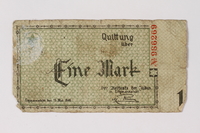
Łódź (Litzmannstadt) ghetto scrip, 1 mark note
Object
1 [eine] mark receipt issued in the Łódź ghetto in Poland beginning in May 1940 until the ghetto was liquidated in summer 1944. Nazi Germany invaded Poland on September 1, 1939, and occupied Łódź one week later. Łódź was renamed Litzmannstadt and, by February 1940, the Germans forcibly relocated the large Jewish population of 160,000 into a small, sealed ghetto. All residents had to work and many were forced laborers in ghetto factories. Residents were forbidden to have German currency, and the Jewish Council was ordered to create a system of Quittungen [receipts] that could be used only in the ghetto. The scrip, sometimes referred to as rumkis, after the Elder of the Judenrat, Mordechai Rumkowski, was issued in 7 denominations: 50 pfenning, 1, 2, 5, 10, 20, 50, and 100 marks, as well as coins. It acted as a labor incentive and facilitated the confiscation of money and goods from internees. There was little to exchange it for in the ghetto. Living conditions were horrendous; the severe overcrowding and lack of food made disease and starvation common. In January 1942, mass deportations to Chelmno killing center began; half the residents were murdered by the end of the year. In summer 1944, Łódź, the last ghetto in Poland, was destroyed and the remaining Jews were sent to Chelmno and Auschwitz-Birkenau killing centers.
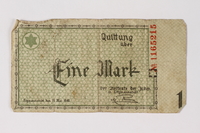
Łódź (Litzmannstadt) ghetto scrip, 1 mark note
Object
1 [eine] mark receipt issued in the Łódź ghetto in Poland beginning in May 1940 until the ghetto was liquidated in summer 1944. Nazi Germany invaded Poland on September 1, 1939, and occupied Łódź one week later. Łódź was renamed Litzmannstadt and, by February 1940, the Germans forcibly relocated the large Jewish population of 160,000 into a small, sealed ghetto. All residents had to work and many were forced laborers in ghetto factories. Residents were forbidden to have German currency, and the Jewish Council was ordered to create a system of Quittungen [receipts] that could be used only in the ghetto. The scrip, sometimes referred to as rumkis, after the Elder of the Judenrat, Mordechai Rumkowski, was issued in 7 denominations: 50 pfenning, 1, 2, 5, 10, 20, 50, and 100 marks, as well as coins. It acted as a labor incentive and facilitated the confiscation of money and goods from internees. There was little to exchange it for in the ghetto. Living conditions were horrendous; the severe overcrowding and lack of food made disease and starvation common. In January 1942, mass deportations to Chelmno killing center began; half the residents were murdered by the end of the year. In summer 1944, Łódź, the last ghetto in Poland, was destroyed and the remaining Jews were sent to Chelmno and Auschwitz-Birkenau killing centers.
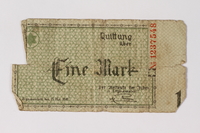
Łódź (Litzmannstadt) ghetto scrip, 1 mark note
Object
1 [eine] mark receipt issued in the Łódź ghetto in Poland beginning in May 1940 until the ghetto was liquidated in summer 1944. Nazi Germany invaded Poland on September 1, 1939, and occupied Łódź one week later. Łódź was renamed Litzmannstadt and, by February 1940, the Germans forcibly relocated the large Jewish population of 160,000 into a small, sealed ghetto. All residents had to work and many were forced laborers in ghetto factories. Residents were forbidden to have German currency, and the Jewish Council was ordered to create a system of Quittungen [receipts] that could be used only in the ghetto. The scrip, sometimes referred to as rumkis, after the Elder of the Judenrat, Mordechai Rumkowski, was issued in 7 denominations: 50 pfenning, 1, 2, 5, 10, 20, 50, and 100 marks, as well as coins. It acted as a labor incentive and facilitated the confiscation of money and goods from internees. There was little to exchange it for in the ghetto. Living conditions were horrendous; the severe overcrowding and lack of food made disease and starvation common. In January 1942, mass deportations to Chelmno killing center began; half the residents were murdered by the end of the year. In summer 1944, Łódź, the last ghetto in Poland, was destroyed and the remaining Jews were sent to Chelmno and Auschwitz-Birkenau killing centers.
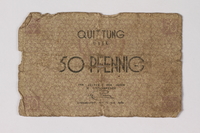
Łódź (Litzmannstadt) ghetto scrip, 50 pfennig note
Object
50 [funfzig] pfennig receipt issued in the Łódź ghetto in Poland beginning in May 1940 until the ghetto was liquidated in summer 1944. Nazi Germany invaded Poland on September 1, 1939, and occupied Łódź one week later. Łódź was renamed Litzmannstadt and, by February 1940, the Germans forcibly relocated the large Jewish population of 160,000 into a small, sealed ghetto. All residents had to work and many were forced laborers in ghetto factories. Residents were forbidden to have German currency, and the Jewish Council was ordered to create a system of Quittungen [receipts] that could be used only in the ghetto. The scrip, sometimes referred to as rumkis, after the Elder of the Judenrat, Mordechai Rumkowski, was issued in 7 denominations: 50 pfenning, 1, 2, 5, 10, 20, 50, and 100 marks, as well as coins. It acted as a labor incentive and facilitated the confiscation of money and goods from internees. There was little to exchange it for in the ghetto. Living conditions were horrendous; the severe overcrowding and lack of food made disease and starvation common. In January 1942, mass deportations to Chelmno killing center began; half the residents were murdered by the end of the year. In summer 1944, Łódź, the last ghetto in Poland, was destroyed and the remaining Jews were sent to Chelmno and Auschwitz-Birkenau killing centers.

Łódź (Litzmannstadt) ghetto scrip, 50 pfennig note
Object
50 [funfzig] pfennig receipt issued in the Łódź ghetto in Poland beginning in May 1940 until the ghetto was liquidated in summer 1944. Nazi Germany invaded Poland on September 1, 1939, and occupied Łódź one week later. Łódź was renamed Litzmannstadt and, by February 1940, the Germans forcibly relocated the large Jewish population of 160,000 into a small, sealed ghetto. All residents had to work and many were forced laborers in ghetto factories. Residents were forbidden to have German currency, and the Jewish Council was ordered to create a system of Quittungen [receipts] that could be used only in the ghetto. The scrip, sometimes referred to as rumkis, after the Elder of the Judenrat, Mordechai Rumkowski, was issued in 7 denominations: 50 pfenning, 1, 2, 5, 10, 20, 50, and 100 marks, as well as coins. It acted as a labor incentive and facilitated the confiscation of money and goods from internees. There was little to exchange it for in the ghetto. Living conditions were horrendous; the severe overcrowding and lack of food made disease and starvation common. In January 1942, mass deportations to Chelmno killing center began; half the residents were murdered by the end of the year. In summer 1944, Łódź, the last ghetto in Poland, was destroyed and the remaining Jews were sent to Chelmno and Auschwitz-Birkenau killing centers.
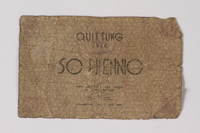
Łódź (Litzmannstadt) ghetto scrip, 50 pfennig note
Object
50 [funfzig] pfennig receipt issued in the Łódź ghetto in Poland beginning in May 1940 until the ghetto was liquidated in summer 1944. Nazi Germany invaded Poland on September 1, 1939, and occupied Łódź one week later. Łódź was renamed Litzmannstadt and, by February 1940, the Germans forcibly relocated the large Jewish population of 160,000 into a small, sealed ghetto. All residents had to work and many were forced laborers in ghetto factories. Residents were forbidden to have German currency, and the Jewish Council was ordered to create a system of Quittungen [receipts] that could be used only in the ghetto. The scrip, sometimes referred to as rumkis, after the Elder of the Judenrat, Mordechai Rumkowski, was issued in 7 denominations: 50 pfenning, 1, 2, 5, 10, 20, 50, and 100 marks, as well as coins. It acted as a labor incentive and facilitated the confiscation of money and goods from internees. There was little to exchange it for in the ghetto. Living conditions were horrendous; the severe overcrowding and lack of food made disease and starvation common. In January 1942, mass deportations to Chelmno killing center began; half the residents were murdered by the end of the year. In summer 1944, Łódź, the last ghetto in Poland, was destroyed and the remaining Jews were sent to Chelmno and Auschwitz-Birkenau killing centers.
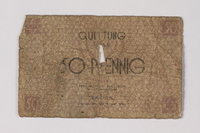
Łódź (Litzmannstadt) ghetto scrip, 50 pfennig note
Object
50 [funfzig] pfennig receipt issued in the Łódź ghetto in Poland beginning in May 1940 until the ghetto was liquidated in summer 1944. Nazi Germany invaded Poland on September 1, 1939, and occupied Łódź one week later. Łódź was renamed Litzmannstadt and, by February 1940, the Germans forcibly relocated the large Jewish population of 160,000 into a small, sealed ghetto. All residents had to work and many were forced laborers in ghetto factories. Residents were forbidden to have German currency, and the Jewish Council was ordered to create a system of Quittungen [receipts] that could be used only in the ghetto. The scrip, sometimes referred to as rumkis, after the Elder of the Judenrat, Mordechai Rumkowski, was issued in 7 denominations: 50 pfenning, 1, 2, 5, 10, 20, 50, and 100 marks, as well as coins. It acted as a labor incentive and facilitated the confiscation of money and goods from internees. There was little to exchange it for in the ghetto. Living conditions were horrendous; the severe overcrowding and lack of food made disease and starvation common. In January 1942, mass deportations to Chelmno killing center began; half the residents were murdered by the end of the year. In summer 1944, Łódź, the last ghetto in Poland, was destroyed and the remaining Jews were sent to Chelmno and Auschwitz-Birkenau killing centers.

Łódź (Litzmannstadt) ghetto scrip, 50 pfennig note
Object
50 [funfzig] pfennig receipt issued in the Łódź ghetto in Poland beginning in May 1940 until the ghetto was liquidated in summer 1944. Nazi Germany invaded Poland on September 1, 1939, and occupied Łódź one week later. Łódź was renamed Litzmannstadt and, by February 1940, the Germans forcibly relocated the large Jewish population of 160,000 into a small, sealed ghetto. All residents had to work and many were forced laborers in ghetto factories. Residents were forbidden to have German currency, and the Jewish Council was ordered to create a system of Quittungen [receipts] that could be used only in the ghetto. The scrip, sometimes referred to as rumkis, after the Elder of the Judenrat, Mordechai Rumkowski, was issued in 7 denominations: 50 pfenning, 1, 2, 5, 10, 20, 50, and 100 marks, as well as coins. It acted as a labor incentive and facilitated the confiscation of money and goods from internees. There was little to exchange it for in the ghetto. Living conditions were horrendous; the severe overcrowding and lack of food made disease and starvation common. In January 1942, mass deportations to Chelmno killing center began; half the residents were murdered by the end of the year. In summer 1944, Łódź, the last ghetto in Poland, was destroyed and the remaining Jews were sent to Chelmno and Auschwitz-Birkenau killing centers.
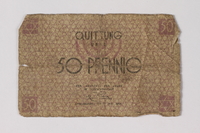
Łódź (Litzmannstadt) ghetto scrip, 50 pfennig note
Object
50 [funfzig] pfennig receipt issued in the Łódź ghetto in Poland beginning in May 1940 until the ghetto was liquidated in summer 1944. Nazi Germany invaded Poland on September 1, 1939, and occupied Łódź one week later. Łódź was renamed Litzmannstadt and, by February 1940, the Germans forcibly relocated the large Jewish population of 160,000 into a small, sealed ghetto. All residents had to work and many were forced laborers in ghetto factories. Residents were forbidden to have German currency, and the Jewish Council was ordered to create a system of Quittungen [receipts] that could be used only in the ghetto. The scrip, sometimes referred to as rumkis, after the Elder of the Judenrat, Mordechai Rumkowski, was issued in 7 denominations: 50 pfenning, 1, 2, 5, 10, 20, 50, and 100 marks, as well as coins. It acted as a labor incentive and facilitated the confiscation of money and goods from internees. There was little to exchange it for in the ghetto. Living conditions were horrendous; the severe overcrowding and lack of food made disease and starvation common. In January 1942, mass deportations to Chelmno killing center began; half the residents were murdered by the end of the year. In summer 1944, Łódź, the last ghetto in Poland, was destroyed and the remaining Jews were sent to Chelmno and Auschwitz-Birkenau killing centers.

Łódź (Litzmannstadt) ghetto scrip, 50 pfennig note
Object
50 [funfzig] pfennig receipt issued in the Łódź ghetto in Poland beginning in May 1940 until the ghetto was liquidated in summer 1944. Nazi Germany invaded Poland on September 1, 1939, and occupied Łódź one week later. Łódź was renamed Litzmannstadt and, by February 1940, the Germans forcibly relocated the large Jewish population of 160,000 into a small, sealed ghetto. All residents had to work and many were forced laborers in ghetto factories. Residents were forbidden to have German currency, and the Jewish Council was ordered to create a system of Quittungen [receipts] that could be used only in the ghetto. The scrip, sometimes referred to as rumkis, after the Elder of the Judenrat, Mordechai Rumkowski, was issued in 7 denominations: 50 pfenning, 1, 2, 5, 10, 20, 50, and 100 marks, as well as coins. It acted as a labor incentive and facilitated the confiscation of money and goods from internees. There was little to exchange it for in the ghetto. Living conditions were horrendous; the severe overcrowding and lack of food made disease and starvation common. In January 1942, mass deportations to Chelmno killing center began; half the residents were murdered by the end of the year. In summer 1944, Łódź, the last ghetto in Poland, was destroyed and the remaining Jews were sent to Chelmno and Auschwitz-Birkenau killing centers.
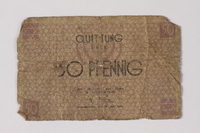
Łódź (Litzmannstadt) ghetto scrip, 50 pfennig note
Object
50 [funfzig] pfennig receipt issued in the Łódź ghetto in Poland beginning in May 1940 until the ghetto was liquidated in summer 1944. Nazi Germany invaded Poland on September 1, 1939, and occupied Łódź one week later. Łódź was renamed Litzmannstadt and, by February 1940, the Germans forcibly relocated the large Jewish population of 160,000 into a small, sealed ghetto. All residents had to work and many were forced laborers in ghetto factories. Residents were forbidden to have German currency, and the Jewish Council was ordered to create a system of Quittungen [receipts] that could be used only in the ghetto. The scrip, sometimes referred to as rumkis, after the Elder of the Judenrat, Mordechai Rumkowski, was issued in 7 denominations: 50 pfenning, 1, 2, 5, 10, 20, 50, and 100 marks, as well as coins. It acted as a labor incentive and facilitated the confiscation of money and goods from internees. There was little to exchange it for in the ghetto. Living conditions were horrendous; the severe overcrowding and lack of food made disease and starvation common. In January 1942, mass deportations to Chelmno killing center began; half the residents were murdered by the end of the year. In summer 1944, Łódź, the last ghetto in Poland, was destroyed and the remaining Jews were sent to Chelmno and Auschwitz-Birkenau killing centers.

Łódź (Litzmannstadt) ghetto scrip, 50 pfennig note
Object
50 [funfzig] pfennig receipt issued in the Łódź ghetto in Poland beginning in May 1940 until the ghetto was liquidated in summer 1944. Nazi Germany invaded Poland on September 1, 1939, and occupied Łódź one week later. Łódź was renamed Litzmannstadt and, by February 1940, the Germans forcibly relocated the large Jewish population of 160,000 into a small, sealed ghetto. All residents had to work and many were forced laborers in ghetto factories. Residents were forbidden to have German currency, and the Jewish Council was ordered to create a system of Quittungen [receipts] that could be used only in the ghetto. The scrip, sometimes referred to as rumkis, after the Elder of the Judenrat, Mordechai Rumkowski, was issued in 7 denominations: 50 pfenning, 1, 2, 5, 10, 20, 50, and 100 marks, as well as coins. It acted as a labor incentive and facilitated the confiscation of money and goods from internees. There was little to exchange it for in the ghetto. Living conditions were horrendous; the severe overcrowding and lack of food made disease and starvation common. In January 1942, mass deportations to Chelmno killing center began; half the residents were murdered by the end of the year. In summer 1944, Łódź, the last ghetto in Poland, was destroyed and the remaining Jews were sent to Chelmno and Auschwitz-Birkenau killing centers.

Łódź (Litzmannstadt) ghetto scrip, 50 pfennig note
Object
50 [funfzig] pfennig receipt issued in the Łódź ghetto in Poland beginning in May 1940 until the ghetto was liquidated in summer 1944. Nazi Germany invaded Poland on September 1, 1939, and occupied Łódź one week later. Łódź was renamed Litzmannstadt and, by February 1940, the Germans forcibly relocated the large Jewish population of 160,000 into a small, sealed ghetto. All residents had to work and many were forced laborers in ghetto factories. Residents were forbidden to have German currency, and the Jewish Council was ordered to create a system of Quittungen [receipts] that could be used only in the ghetto. The scrip, sometimes referred to as rumkis, after the Elder of the Judenrat, Mordechai Rumkowski, was issued in 7 denominations: 50 pfenning, 1, 2, 5, 10, 20, 50, and 100 marks, as well as coins. It acted as a labor incentive and facilitated the confiscation of money and goods from internees. There was little to exchange it for in the ghetto. Living conditions were horrendous; the severe overcrowding and lack of food made disease and starvation common. In January 1942, mass deportations to Chelmno killing center began; half the residents were murdered by the end of the year. In summer 1944, Łódź, the last ghetto in Poland, was destroyed and the remaining Jews were sent to Chelmno and Auschwitz-Birkenau killing centers.

Łódź (Litzmannstadt) ghetto scrip, 50 pfennig note
Object
50 [funfzig] pfennig receipt issued in the Łódź ghetto in Poland beginning in May 1940 until the ghetto was liquidated in summer 1944. Nazi Germany invaded Poland on September 1, 1939, and occupied Łódź one week later. Łódź was renamed Litzmannstadt and, by February 1940, the Germans forcibly relocated the large Jewish population of 160,000 into a small, sealed ghetto. All residents had to work and many were forced laborers in ghetto factories. Residents were forbidden to have German currency, and the Jewish Council was ordered to create a system of Quittungen [receipts] that could be used only in the ghetto. The scrip, sometimes referred to as rumkis, after the Elder of the Judenrat, Mordechai Rumkowski, was issued in 7 denominations: 50 pfenning, 1, 2, 5, 10, 20, 50, and 100 marks, as well as coins. It acted as a labor incentive and facilitated the confiscation of money and goods from internees. There was little to exchange it for in the ghetto. Living conditions were horrendous; the severe overcrowding and lack of food made disease and starvation common. In January 1942, mass deportations to Chelmno killing center began; half the residents were murdered by the end of the year. In summer 1944, Łódź, the last ghetto in Poland, was destroyed and the remaining Jews were sent to Chelmno and Auschwitz-Birkenau killing centers.
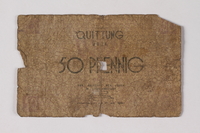
Łódź (Litzmannstadt) ghetto scrip, 50 pfennig note
Object
50 [funfzig] pfennig receipt issued in the Łódź ghetto in Poland beginning in May 1940 until the ghetto was liquidated in summer 1944. Nazi Germany invaded Poland on September 1, 1939, and occupied Łódź one week later. Łódź was renamed Litzmannstadt and, by February 1940, the Germans forcibly relocated the large Jewish population of 160,000 into a small, sealed ghetto. All residents had to work and many were forced laborers in ghetto factories. Residents were forbidden to have German currency, and the Jewish Council was ordered to create a system of Quittungen [receipts] that could be used only in the ghetto. The scrip, sometimes referred to as rumkis, after the Elder of the Judenrat, Mordechai Rumkowski, was issued in 7 denominations: 50 pfenning, 1, 2, 5, 10, 20, 50, and 100 marks, as well as coins. It acted as a labor incentive and facilitated the confiscation of money and goods from internees. There was little to exchange it for in the ghetto. Living conditions were horrendous; the severe overcrowding and lack of food made disease and starvation common. In January 1942, mass deportations to Chelmno killing center began; half the residents were murdered by the end of the year. In summer 1944, Łódź, the last ghetto in Poland, was destroyed and the remaining Jews were sent to Chelmno and Auschwitz-Birkenau killing centers.
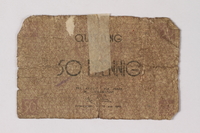
Łódź (Litzmannstadt) ghetto scrip, 50 pfennig note
Object
50 [funfzig] pfennig receipt issued in the Łódź ghetto in Poland beginning in May 1940 until the ghetto was liquidated in summer 1944. Nazi Germany invaded Poland on September 1, 1939, and occupied Łódź one week later. Łódź was renamed Litzmannstadt and, by February 1940, the Germans forcibly relocated the large Jewish population of 160,000 into a small, sealed ghetto. All residents had to work and many were forced laborers in ghetto factories. Residents were forbidden to have German currency, and the Jewish Council was ordered to create a system of Quittungen [receipts] that could be used only in the ghetto. The scrip, sometimes referred to as rumkis, after the Elder of the Judenrat, Mordechai Rumkowski, was issued in 7 denominations: 50 pfenning, 1, 2, 5, 10, 20, 50, and 100 marks, as well as coins. It acted as a labor incentive and facilitated the confiscation of money and goods from internees. There was little to exchange it for in the ghetto. Living conditions were horrendous; the severe overcrowding and lack of food made disease and starvation common. In January 1942, mass deportations to Chelmno killing center began; half the residents were murdered by the end of the year. In summer 1944, Łódź, the last ghetto in Poland, was destroyed and the remaining Jews were sent to Chelmno and Auschwitz-Birkenau killing centers.
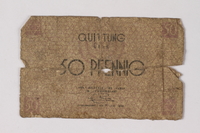
Łódź (Litzmannstadt) ghetto scrip, 50 pfennig note
Object
50 [funfzig] pfennig receipt issued in the Łódź ghetto in Poland beginning in May 1940 until the ghetto was liquidated in summer 1944. Nazi Germany invaded Poland on September 1, 1939, and occupied Łódź one week later. Łódź was renamed Litzmannstadt and, by February 1940, the Germans forcibly relocated the large Jewish population of 160,000 into a small, sealed ghetto. All residents had to work and many were forced laborers in ghetto factories. Residents were forbidden to have German currency, and the Jewish Council was ordered to create a system of Quittungen [receipts] that could be used only in the ghetto. The scrip, sometimes referred to as rumkis, after the Elder of the Judenrat, Mordechai Rumkowski, was issued in 7 denominations: 50 pfenning, 1, 2, 5, 10, 20, 50, and 100 marks, as well as coins. It acted as a labor incentive and facilitated the confiscation of money and goods from internees. There was little to exchange it for in the ghetto. Living conditions were horrendous; the severe overcrowding and lack of food made disease and starvation common. In January 1942, mass deportations to Chelmno killing center began; half the residents were murdered by the end of the year. In summer 1944, Łódź, the last ghetto in Poland, was destroyed and the remaining Jews were sent to Chelmno and Auschwitz-Birkenau killing centers.
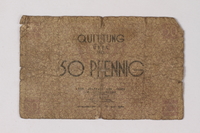
Łódź (Litzmannstadt) ghetto scrip, 50 pfennig note
Object
50 [funfzig] pfennig receipt issued in the Łódź ghetto in Poland beginning in May 1940 until the ghetto was liquidated in summer 1944. Nazi Germany invaded Poland on September 1, 1939, and occupied Łódź one week later. Łódź was renamed Litzmannstadt and, by February 1940, the Germans forcibly relocated the large Jewish population of 160,000 into a small, sealed ghetto. All residents had to work and many were forced laborers in ghetto factories. Residents were forbidden to have German currency, and the Jewish Council was ordered to create a system of Quittungen [receipts] that could be used only in the ghetto. The scrip, sometimes referred to as rumkis, after the Elder of the Judenrat, Mordechai Rumkowski, was issued in 7 denominations: 50 pfenning, 1, 2, 5, 10, 20, 50, and 100 marks, as well as coins. It acted as a labor incentive and facilitated the confiscation of money and goods from internees. There was little to exchange it for in the ghetto. Living conditions were horrendous; the severe overcrowding and lack of food made disease and starvation common. In January 1942, mass deportations to Chelmno killing center began; half the residents were murdered by the end of the year. In summer 1944, Łódź, the last ghetto in Poland, was destroyed and the remaining Jews were sent to Chelmno and Auschwitz-Birkenau killing centers.
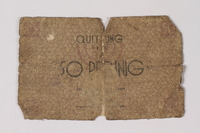
Łódź (Litzmannstadt) ghetto scrip, 50 pfennig note
Object
50 [funfzig] pfennig receipt issued in the Łódź ghetto in Poland beginning in May 1940 until the ghetto was liquidated in summer 1944. Nazi Germany invaded Poland on September 1, 1939, and occupied Łódź one week later. Łódź was renamed Litzmannstadt and, by February 1940, the Germans forcibly relocated the large Jewish population of 160,000 into a small, sealed ghetto. All residents had to work and many were forced laborers in ghetto factories. Residents were forbidden to have German currency, and the Jewish Council was ordered to create a system of Quittungen [receipts] that could be used only in the ghetto. The scrip, sometimes referred to as rumkis, after the Elder of the Judenrat, Mordechai Rumkowski, was issued in 7 denominations: 50 pfenning, 1, 2, 5, 10, 20, 50, and 100 marks, as well as coins. It acted as a labor incentive and facilitated the confiscation of money and goods from internees. There was little to exchange it for in the ghetto. Living conditions were horrendous; the severe overcrowding and lack of food made disease and starvation common. In January 1942, mass deportations to Chelmno killing center began; half the residents were murdered by the end of the year. In summer 1944, Łódź, the last ghetto in Poland, was destroyed and the remaining Jews were sent to Chelmno and Auschwitz-Birkenau killing centers.
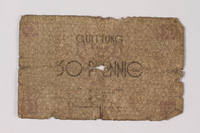
Łódź (Litzmannstadt) ghetto scrip, 50 pfennig note
Object
50 [funfzig] pfennig receipt issued in the Łódź ghetto in Poland beginning in May 1940 until the ghetto was liquidated in summer 1944. Nazi Germany invaded Poland on September 1, 1939, and occupied Łódź one week later. Łódź was renamed Litzmannstadt and, by February 1940, the Germans forcibly relocated the large Jewish population of 160,000 into a small, sealed ghetto. All residents had to work and many were forced laborers in ghetto factories. Residents were forbidden to have German currency, and the Jewish Council was ordered to create a system of Quittungen [receipts] that could be used only in the ghetto. The scrip, sometimes referred to as rumkis, after the Elder of the Judenrat, Mordechai Rumkowski, was issued in 7 denominations: 50 pfenning, 1, 2, 5, 10, 20, 50, and 100 marks, as well as coins. It acted as a labor incentive and facilitated the confiscation of money and goods from internees. There was little to exchange it for in the ghetto. Living conditions were horrendous; the severe overcrowding and lack of food made disease and starvation common. In January 1942, mass deportations to Chelmno killing center began; half the residents were murdered by the end of the year. In summer 1944, Łódź, the last ghetto in Poland, was destroyed and the remaining Jews were sent to Chelmno and Auschwitz-Birkenau killing centers.
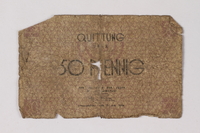
Łódź (Litzmannstadt) ghetto scrip, 50 pfennig note
Object
50 [funfzig] pfennig receipt issued in the Łódź ghetto in Poland beginning in May 1940 until the ghetto was liquidated in summer 1944. Nazi Germany invaded Poland on September 1, 1939, and occupied Łódź one week later. Łódź was renamed Litzmannstadt and, by February 1940, the Germans forcibly relocated the large Jewish population of 160,000 into a small, sealed ghetto. All residents had to work and many were forced laborers in ghetto factories. Residents were forbidden to have German currency, and the Jewish Council was ordered to create a system of Quittungen [receipts] that could be used only in the ghetto. The scrip, sometimes referred to as rumkis, after the Elder of the Judenrat, Mordechai Rumkowski, was issued in 7 denominations: 50 pfenning, 1, 2, 5, 10, 20, 50, and 100 marks, as well as coins. It acted as a labor incentive and facilitated the confiscation of money and goods from internees. There was little to exchange it for in the ghetto. Living conditions were horrendous; the severe overcrowding and lack of food made disease and starvation common. In January 1942, mass deportations to Chelmno killing center began; half the residents were murdered by the end of the year. In summer 1944, Łódź, the last ghetto in Poland, was destroyed and the remaining Jews were sent to Chelmno and Auschwitz-Birkenau killing centers.
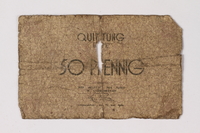
Łódź (Litzmannstadt) ghetto scrip, 50 pfennig note
Object
50 [funfzig] pfennig receipt issued in the Łódź ghetto in Poland beginning in May 1940 until the ghetto was liquidated in summer 1944. Nazi Germany invaded Poland on September 1, 1939, and occupied Łódź one week later. Łódź was renamed Litzmannstadt and, by February 1940, the Germans forcibly relocated the large Jewish population of 160,000 into a small, sealed ghetto. All residents had to work and many were forced laborers in ghetto factories. Residents were forbidden to have German currency, and the Jewish Council was ordered to create a system of Quittungen [receipts] that could be used only in the ghetto. The scrip, sometimes referred to as rumkis, after the Elder of the Judenrat, Mordechai Rumkowski, was issued in 7 denominations: 50 pfenning, 1, 2, 5, 10, 20, 50, and 100 marks, as well as coins. It acted as a labor incentive and facilitated the confiscation of money and goods from internees. There was little to exchange it for in the ghetto. Living conditions were horrendous; the severe overcrowding and lack of food made disease and starvation common. In January 1942, mass deportations to Chelmno killing center began; half the residents were murdered by the end of the year. In summer 1944, Łódź, the last ghetto in Poland, was destroyed and the remaining Jews were sent to Chelmno and Auschwitz-Birkenau killing centers.
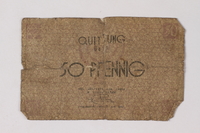
Łódź (Litzmannstadt) ghetto scrip, 50 pfennig note
Object
50 [funfzig] pfennig receipt issued in the Łódź ghetto in Poland beginning in May 1940 until the ghetto was liquidated in summer 1944. Nazi Germany invaded Poland on September 1, 1939, and occupied Łódź one week later. Łódź was renamed Litzmannstadt and, by February 1940, the Germans forcibly relocated the large Jewish population of 160,000 into a small, sealed ghetto. All residents had to work and many were forced laborers in ghetto factories. Residents were forbidden to have German currency, and the Jewish Council was ordered to create a system of Quittungen [receipts] that could be used only in the ghetto. The scrip, sometimes referred to as rumkis, after the Elder of the Judenrat, Mordechai Rumkowski, was issued in 7 denominations: 50 pfenning, 1, 2, 5, 10, 20, 50, and 100 marks, as well as coins. It acted as a labor incentive and facilitated the confiscation of money and goods from internees. There was little to exchange it for in the ghetto. Living conditions were horrendous; the severe overcrowding and lack of food made disease and starvation common. In January 1942, mass deportations to Chelmno killing center began; half the residents were murdered by the end of the year. In summer 1944, Łódź, the last ghetto in Poland, was destroyed and the remaining Jews were sent to Chelmno and Auschwitz-Birkenau killing centers.
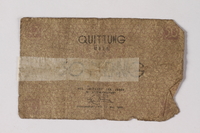
Łódź (Litzmannstadt) ghetto scrip, 50 pfennig note
Object
50 [funfzig] pfennig receipt issued in the Łódź ghetto in Poland beginning in May 1940 until the ghetto was liquidated in summer 1944. Nazi Germany invaded Poland on September 1, 1939, and occupied Łódź one week later. Łódź was renamed Litzmannstadt and, by February 1940, the Germans forcibly relocated the large Jewish population of 160,000 into a small, sealed ghetto. All residents had to work and many were forced laborers in ghetto factories. Residents were forbidden to have German currency, and the Jewish Council was ordered to create a system of Quittungen [receipts] that could be used only in the ghetto. The scrip, sometimes referred to as rumkis, after the Elder of the Judenrat, Mordechai Rumkowski, was issued in 7 denominations: 50 pfenning, 1, 2, 5, 10, 20, 50, and 100 marks, as well as coins. It acted as a labor incentive and facilitated the confiscation of money and goods from internees. There was little to exchange it for in the ghetto. Living conditions were horrendous; the severe overcrowding and lack of food made disease and starvation common. In January 1942, mass deportations to Chelmno killing center began; half the residents were murdered by the end of the year. In summer 1944, Łódź, the last ghetto in Poland, was destroyed and the remaining Jews were sent to Chelmno and Auschwitz-Birkenau killing centers.

Łódź (Litzmannstadt) ghetto scrip, 50 pfennig note
Object
50 [funfzig] pfennig receipt issued in the Łódź ghetto in Poland beginning in May 1940 until the ghetto was liquidated in summer 1944. Nazi Germany invaded Poland on September 1, 1939, and occupied Łódź one week later. Łódź was renamed Litzmannstadt and, by February 1940, the Germans forcibly relocated the large Jewish population of 160,000 into a small, sealed ghetto. All residents had to work and many were forced laborers in ghetto factories. Residents were forbidden to have German currency, and the Jewish Council was ordered to create a system of Quittungen [receipts] that could be used only in the ghetto. The scrip, sometimes referred to as rumkis, after the Elder of the Judenrat, Mordechai Rumkowski, was issued in 7 denominations: 50 pfenning, 1, 2, 5, 10, 20, 50, and 100 marks, as well as coins. It acted as a labor incentive and facilitated the confiscation of money and goods from internees. There was little to exchange it for in the ghetto. Living conditions were horrendous; the severe overcrowding and lack of food made disease and starvation common. In January 1942, mass deportations to Chelmno killing center began; half the residents were murdered by the end of the year. In summer 1944, Łódź, the last ghetto in Poland, was destroyed and the remaining Jews were sent to Chelmno and Auschwitz-Birkenau killing centers.

Łódź (Litzmannstadt) ghetto scrip, 50 pfennig note
Object
50 [funfzig] pfennig receipt issued in the Łódź ghetto in Poland beginning in May 1940 until the ghetto was liquidated in summer 1944. Nazi Germany invaded Poland on September 1, 1939, and occupied Łódź one week later. Łódź was renamed Litzmannstadt and, by February 1940, the Germans forcibly relocated the large Jewish population of 160,000 into a small, sealed ghetto. All residents had to work and many were forced laborers in ghetto factories. Residents were forbidden to have German currency, and the Jewish Council was ordered to create a system of Quittungen [receipts] that could be used only in the ghetto. The scrip, sometimes referred to as rumkis, after the Elder of the Judenrat, Mordechai Rumkowski, was issued in 7 denominations: 50 pfenning, 1, 2, 5, 10, 20, 50, and 100 marks, as well as coins. It acted as a labor incentive and facilitated the confiscation of money and goods from internees. There was little to exchange it for in the ghetto. Living conditions were horrendous; the severe overcrowding and lack of food made disease and starvation common. In January 1942, mass deportations to Chelmno killing center began; half the residents were murdered by the end of the year. In summer 1944, Łódź, the last ghetto in Poland, was destroyed and the remaining Jews were sent to Chelmno and Auschwitz-Birkenau killing centers.

Łódź (Litzmannstadt) ghetto scrip, 50 pfennig note
Object
50 [funfzig] pfennig receipt issued in the Łódź ghetto in Poland beginning in May 1940 until the ghetto was liquidated in summer 1944. Nazi Germany invaded Poland on September 1, 1939, and occupied Łódź one week later. Łódź was renamed Litzmannstadt and, by February 1940, the Germans forcibly relocated the large Jewish population of 160,000 into a small, sealed ghetto. All residents had to work and many were forced laborers in ghetto factories. Residents were forbidden to have German currency, and the Jewish Council was ordered to create a system of Quittungen [receipts] that could be used only in the ghetto. The scrip, sometimes referred to as rumkis, after the Elder of the Judenrat, Mordechai Rumkowski, was issued in 7 denominations: 50 pfenning, 1, 2, 5, 10, 20, 50, and 100 marks, as well as coins. It acted as a labor incentive and facilitated the confiscation of money and goods from internees. There was little to exchange it for in the ghetto. Living conditions were horrendous; the severe overcrowding and lack of food made disease and starvation common. In January 1942, mass deportations to Chelmno killing center began; half the residents were murdered by the end of the year. In summer 1944, Łódź, the last ghetto in Poland, was destroyed and the remaining Jews were sent to Chelmno and Auschwitz-Birkenau killing centers.

Łódź (Litzmannstadt) ghetto scrip, 10 mark coin
Object
10 mark coin token issued in 1943 in Łódź Ghetto in German occupied Poland. Nazi Germany invaded Poland on September 1, 1939, and occupied Łódź one week later. Łódź was renamed Litzmannstadt and, by February 1940, the Germans forcibly relocated the large Jewish population of 160,000 into a small, sealed ghetto. Residents had to do forced labor, many in ghetto factories. Residents were forbidden to have German currency, and the Jewish Council was ordered to create a system of Quittungen [receipts] for use only in the Ghetto. Coins were issued in 4 denominations: 10 pfennig, and 5,10, and 20 mark. Paper scrip was issued in 7 denominations: 50 pfenning, 1, 2, 5, 10, 20, 50, and 100 marks. It acted as a labor incentive and facilitated the confiscation of money and goods from internees. There was little to exchange it for in the Ghetto. Living conditions were horrendous; the severe overcrowding and lack of food made disease and starvation common. In January 1942, mass deportations to Chelmno killing center began; half the residents were murdered by the end of the year. In summer 1944, Łódź, the last ghetto in Poland, was destroyed and the remaining Jews were sent to Chelmno and Auschwitz-Birkenau killing centers.
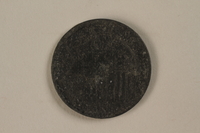
Łódź (Litzmannstadt) ghetto scrip, 10 mark coin
Object
10 mark coin token issued in 1943 in Łódź Ghetto in German occupied Poland. Nazi Germany invaded Poland on September 1, 1939, and occupied Łódź one week later. Łódź was renamed Litzmannstadt and, by February 1940, the Germans forcibly relocated the large Jewish population of 160,000 into a small, sealed ghetto. Residents had to do forced labor, many in ghetto factories. Residents were forbidden to have German currency, and the Jewish Council was ordered to create a system of Quittungen [receipts] for use only in the Ghetto. Coins were issued in 4 denominations: 10 pfennig, and 5,10, and 20 mark. Paper scrip was issued in 7 denominations: 50 pfenning, 1, 2, 5, 10, 20, 50, and 100 marks. It acted as a labor incentive and facilitated the confiscation of money and goods from internees. There was little to exchange it for in the Ghetto. Living conditions were horrendous; the severe overcrowding and lack of food made disease and starvation common. In January 1942, mass deportations to Chelmno killing center began; half the residents were murdered by the end of the year. In summer 1944, Łódź, the last ghetto in Poland, was destroyed and the remaining Jews were sent to Chelmno and Auschwitz-Birkenau killing centers.

Łódź (Litzmannstadt) ghetto scrip, 10 mark coin
Object
10 mark coin token issued in 1943 in Łódź Ghetto in German occupied Poland. Nazi Germany invaded Poland on September 1, 1939, and occupied Łódź one week later. Łódź was renamed Litzmannstadt and, by February 1940, the Germans forcibly relocated the large Jewish population of 160,000 into a small, sealed ghetto. Residents had to do forced labor, many in ghetto factories. Residents were forbidden to have German currency, and the Jewish Council was ordered to create a system of Quittungen [receipts] for use only in the Ghetto. Coins were issued in 4 denominations: 10 pfennig, and 5,10, and 20 mark. Paper scrip was issued in 7 denominations: 50 pfenning, 1, 2, 5, 10, 20, 50, and 100 marks. It acted as a labor incentive and facilitated the confiscation of money and goods from internees. There was little to exchange it for in the Ghetto. Living conditions were horrendous; the severe overcrowding and lack of food made disease and starvation common. In January 1942, mass deportations to Chelmno killing center began; half the residents were murdered by the end of the year. In summer 1944, Łódź, the last ghetto in Poland, was destroyed and the remaining Jews were sent to Chelmno and Auschwitz-Birkenau killing centers.

Łódź (Litzmannstadt) ghetto scrip, 10 mark coin
Object
10 mark coin token issued in 1943 in Łódź Ghetto in German occupied Poland. Nazi Germany invaded Poland on September 1, 1939, and occupied Łódź one week later. Łódź was renamed Litzmannstadt and, by February 1940, the Germans forcibly relocated the large Jewish population of 160,000 into a small, sealed ghetto. Residents had to do forced labor, many in ghetto factories. Residents were forbidden to have German currency, and the Jewish Council was ordered to create a system of Quittungen [receipts] for use only in the Ghetto. Coins were issued in 4 denominations: 10 pfennig, and 5,10, and 20 mark. Paper scrip was issued in 7 denominations: 50 pfenning, 1, 2, 5, 10, 20, 50, and 100 marks. It acted as a labor incentive and facilitated the confiscation of money and goods from internees. There was little to exchange it for in the Ghetto. Living conditions were horrendous; the severe overcrowding and lack of food made disease and starvation common. In January 1942, mass deportations to Chelmno killing center began; half the residents were murdered by the end of the year. In summer 1944, Łódź, the last ghetto in Poland, was destroyed and the remaining Jews were sent to Chelmno and Auschwitz-Birkenau killing centers.

Łódź (Litzmannstadt) ghetto scrip, 10 mark coin
Object
10 mark coin token issued in 1943 in Łódź Ghetto in German occupied Poland. Nazi Germany invaded Poland on September 1, 1939, and occupied Łódź one week later. Łódź was renamed Litzmannstadt and, by February 1940, the Germans forcibly relocated the large Jewish population of 160,000 into a small, sealed ghetto. Residents had to do forced labor, many in ghetto factories. Residents were forbidden to have German currency, and the Jewish Council was ordered to create a system of Quittungen [receipts] for use only in the Ghetto. Coins were issued in 4 denominations: 10 pfennig, and 5,10, and 20 mark. Paper scrip was issued in 7 denominations: 50 pfenning, 1, 2, 5, 10, 20, 50, and 100 marks. It acted as a labor incentive and facilitated the confiscation of money and goods from internees. There was little to exchange it for in the Ghetto. Living conditions were horrendous; the severe overcrowding and lack of food made disease and starvation common. In January 1942, mass deportations to Chelmno killing center began; half the residents were murdered by the end of the year. In summer 1944, Łódź, the last ghetto in Poland, was destroyed and the remaining Jews were sent to Chelmno and Auschwitz-Birkenau killing centers.

Łódź (Litzmannstadt) ghetto scrip, 10 mark coin
Object
10 mark coin token issued in 1943 in Łódź Ghetto in German occupied Poland. Nazi Germany invaded Poland on September 1, 1939, and occupied Łódź one week later. Łódź was renamed Litzmannstadt and, by February 1940, the Germans forcibly relocated the large Jewish population of 160,000 into a small, sealed ghetto. Residents had to do forced labor, many in ghetto factories. Residents were forbidden to have German currency, and the Jewish Council was ordered to create a system of Quittungen [receipts] for use only in the Ghetto. Coins were issued in 4 denominations: 10 pfennig, and 5,10, and 20 mark. Paper scrip was issued in 7 denominations: 50 pfenning, 1, 2, 5, 10, 20, 50, and 100 marks. It acted as a labor incentive and facilitated the confiscation of money and goods from internees. There was little to exchange it for in the Ghetto. Living conditions were horrendous; the severe overcrowding and lack of food made disease and starvation common. In January 1942, mass deportations to Chelmno killing center began; half the residents were murdered by the end of the year. In summer 1944, Łódź, the last ghetto in Poland, was destroyed and the remaining Jews were sent to Chelmno and Auschwitz-Birkenau killing centers.
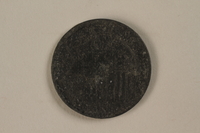
Łódź (Litzmannstadt) ghetto scrip, 10 mark coin
Object
10 mark coin token issued in 1943 in Łódź Ghetto in German occupied Poland. Nazi Germany invaded Poland on September 1, 1939, and occupied Łódź one week later. Łódź was renamed Litzmannstadt and, by February 1940, the Germans forcibly relocated the large Jewish population of 160,000 into a small, sealed ghetto. Residents had to do forced labor, many in ghetto factories. Residents were forbidden to have German currency, and the Jewish Council was ordered to create a system of Quittungen [receipts] for use only in the Ghetto. Coins were issued in 4 denominations: 10 pfennig, and 5,10, and 20 mark. Paper scrip was issued in 7 denominations: 50 pfenning, 1, 2, 5, 10, 20, 50, and 100 marks. It acted as a labor incentive and facilitated the confiscation of money and goods from internees. There was little to exchange it for in the Ghetto. Living conditions were horrendous; the severe overcrowding and lack of food made disease and starvation common. In January 1942, mass deportations to Chelmno killing center began; half the residents were murdered by the end of the year. In summer 1944, Łódź, the last ghetto in Poland, was destroyed and the remaining Jews were sent to Chelmno and Auschwitz-Birkenau killing centers.
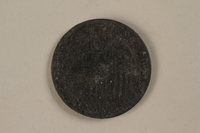
Łódź (Litzmannstadt) ghetto scrip, 10 mark coin
Object
10 mark coin token issued in 1943 in Łódź Ghetto in German occupied Poland. Nazi Germany invaded Poland on September 1, 1939, and occupied Łódź one week later. Łódź was renamed Litzmannstadt and, by February 1940, the Germans forcibly relocated the large Jewish population of 160,000 into a small, sealed ghetto. Residents had to do forced labor, many in ghetto factories. Residents were forbidden to have German currency, and the Jewish Council was ordered to create a system of Quittungen [receipts] for use only in the Ghetto. Coins were issued in 4 denominations: 10 pfennig, and 5,10, and 20 mark. Paper scrip was issued in 7 denominations: 50 pfenning, 1, 2, 5, 10, 20, 50, and 100 marks. It acted as a labor incentive and facilitated the confiscation of money and goods from internees. There was little to exchange it for in the Ghetto. Living conditions were horrendous; the severe overcrowding and lack of food made disease and starvation common. In January 1942, mass deportations to Chelmno killing center began; half the residents were murdered by the end of the year. In summer 1944, Łódź, the last ghetto in Poland, was destroyed and the remaining Jews were sent to Chelmno and Auschwitz-Birkenau killing centers.

Łódź (Litzmannstadt) ghetto scrip, 5 mark coin
Object
5 mark coin token issued in 1943 in Łódź Ghetto in German occupied Poland. Nazi Germany invaded Poland on September 1, 1939, and occupied Łódź one week later. Łódź was renamed Litzmannstadt and, by February 1940, the Germans forcibly relocated the large Jewish population of 160,000 into a small, sealed ghetto. Residents had to do forced labor, many in ghetto factories. Residents were forbidden to have German currency, and the Jewish Council was ordered to create a system of Quittungen [receipts] for use only in the Ghetto. Coins were issued in 4 denominations: 10 pfennig, and 5,10, and 20 mark. Paper scrip was issued in 7 denominations: 50 pfenning, 1, 2, 5, 10, 20, 50, and 100 marks. It acted as a labor incentive and facilitated the confiscation of money and goods from internees. There was little to exchange it for in the Ghetto. Living conditions were horrendous; the severe overcrowding and lack of food made disease and starvation common. In January 1942, mass deportations to Chelmno killing center began; half the residents were murdered by the end of the year. In summer 1944, Łódź, the last ghetto in Poland, was destroyed and the remaining Jews were sent to Chelmno and Auschwitz-Birkenau killing centers.
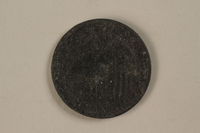
Łódź (Litzmannstadt) ghetto scrip, 5 mark coin
Object
5 mark coin token issued in 1943 in Łódź Ghetto in German occupied Poland. Nazi Germany invaded Poland on September 1, 1939, and occupied Łódź one week later. Łódź was renamed Litzmannstadt and, by February 1940, the Germans forcibly relocated the large Jewish population of 160,000 into a small, sealed ghetto. Residents had to do forced labor, many in ghetto factories. Residents were forbidden to have German currency, and the Jewish Council was ordered to create a system of Quittungen [receipts] for use only in the Ghetto. Coins were issued in 4 denominations: 10 pfennig, and 5,10, and 20 mark. Paper scrip was issued in 7 denominations: 50 pfenning, 1, 2, 5, 10, 20, 50, and 100 marks. It acted as a labor incentive and facilitated the confiscation of money and goods from internees. There was little to exchange it for in the Ghetto. Living conditions were horrendous; the severe overcrowding and lack of food made disease and starvation common. In January 1942, mass deportations to Chelmno killing center began; half the residents were murdered by the end of the year. In summer 1944, Łódź, the last ghetto in Poland, was destroyed and the remaining Jews were sent to Chelmno and Auschwitz-Birkenau killing centers.

Łódź (Litzmannstadt) ghetto scrip, 5 mark coin
Object
5 mark coin token issued in 1943 in Łódź Ghetto in German occupied Poland. Nazi Germany invaded Poland on September 1, 1939, and occupied Łódź one week later. Łódź was renamed Litzmannstadt and, by February 1940, the Germans forcibly relocated the large Jewish population of 160,000 into a small, sealed ghetto. Residents had to do forced labor, many in ghetto factories. Residents were forbidden to have German currency, and the Jewish Council was ordered to create a system of Quittungen [receipts] for use only in the Ghetto. Coins were issued in 4 denominations: 10 pfennig, and 5,10, and 20 mark. Paper scrip was issued in 7 denominations: 50 pfenning, 1, 2, 5, 10, 20, 50, and 100 marks. It acted as a labor incentive and facilitated the confiscation of money and goods from internees. There was little to exchange it for in the Ghetto. Living conditions were horrendous; the severe overcrowding and lack of food made disease and starvation common. In January 1942, mass deportations to Chelmno killing center began; half the residents were murdered by the end of the year. In summer 1944, Łódź, the last ghetto in Poland, was destroyed and the remaining Jews were sent to Chelmno and Auschwitz-Birkenau killing centers.

Łódź (Litzmannstadt) ghetto scrip, 5 mark coin
Object
5 mark coin token issued in 1943 in Łódź Ghetto in German occupied Poland. Nazi Germany invaded Poland on September 1, 1939, and occupied Łódź one week later. Łódź was renamed Litzmannstadt and, by February 1940, the Germans forcibly relocated the large Jewish population of 160,000 into a small, sealed ghetto. Residents had to do forced labor, many in ghetto factories. Residents were forbidden to have German currency, and the Jewish Council was ordered to create a system of Quittungen [receipts] for use only in the Ghetto. Coins were issued in 4 denominations: 10 pfennig, and 5,10, and 20 mark. Paper scrip was issued in 7 denominations: 50 pfenning, 1, 2, 5, 10, 20, 50, and 100 marks. It acted as a labor incentive and facilitated the confiscation of money and goods from internees. There was little to exchange it for in the Ghetto. Living conditions were horrendous; the severe overcrowding and lack of food made disease and starvation common. In January 1942, mass deportations to Chelmno killing center began; half the residents were murdered by the end of the year. In summer 1944, Łódź, the last ghetto in Poland, was destroyed and the remaining Jews were sent to Chelmno and Auschwitz-Birkenau killing centers.

Łódź (Litzmannstadt) ghetto scrip, 5 mark coin
Object
5 mark coin token issued in 1943 in Łódź Ghetto in German occupied Poland. Nazi Germany invaded Poland on September 1, 1939, and occupied Łódź one week later. Łódź was renamed Litzmannstadt and, by February 1940, the Germans forcibly relocated the large Jewish population of 160,000 into a small, sealed ghetto. Residents had to do forced labor, many in ghetto factories. Residents were forbidden to have German currency, and the Jewish Council was ordered to create a system of Quittungen [receipts] for use only in the Ghetto. Coins were issued in 4 denominations: 10 pfennig, and 5,10, and 20 mark. Paper scrip was issued in 7 denominations: 50 pfenning, 1, 2, 5, 10, 20, 50, and 100 marks. It acted as a labor incentive and facilitated the confiscation of money and goods from internees. There was little to exchange it for in the Ghetto. Living conditions were horrendous; the severe overcrowding and lack of food made disease and starvation common. In January 1942, mass deportations to Chelmno killing center began; half the residents were murdered by the end of the year. In summer 1944, Łódź, the last ghetto in Poland, was destroyed and the remaining Jews were sent to Chelmno and Auschwitz-Birkenau killing centers.
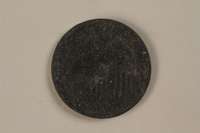
Łódź (Litzmannstadt) ghetto scrip, 5 mark coin
Object
5 mark coin token issued in 1943 in Łódź Ghetto in German occupied Poland. Nazi Germany invaded Poland on September 1, 1939, and occupied Łódź one week later. Łódź was renamed Litzmannstadt and, by February 1940, the Germans forcibly relocated the large Jewish population of 160,000 into a small, sealed ghetto. Residents had to do forced labor, many in ghetto factories. Residents were forbidden to have German currency, and the Jewish Council was ordered to create a system of Quittungen [receipts] for use only in the Ghetto. Coins were issued in 4 denominations: 10 pfennig, and 5,10, and 20 mark. Paper scrip was issued in 7 denominations: 50 pfenning, 1, 2, 5, 10, 20, 50, and 100 marks. It acted as a labor incentive and facilitated the confiscation of money and goods from internees. There was little to exchange it for in the Ghetto. Living conditions were horrendous; the severe overcrowding and lack of food made disease and starvation common. In January 1942, mass deportations to Chelmno killing center began; half the residents were murdered by the end of the year. In summer 1944, Łódź, the last ghetto in Poland, was destroyed and the remaining Jews were sent to Chelmno and Auschwitz-Birkenau killing centers.
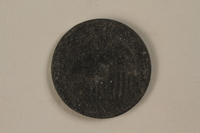
Łódź (Litzmannstadt) ghetto scrip, 5 mark coin
Object
5 mark coin token issued in 1943 in Łódź Ghetto in German occupied Poland. Nazi Germany invaded Poland on September 1, 1939, and occupied Łódź one week later. Łódź was renamed Litzmannstadt and, by February 1940, the Germans forcibly relocated the large Jewish population of 160,000 into a small, sealed ghetto. Residents had to do forced labor, many in ghetto factories. Residents were forbidden to have German currency, and the Jewish Council was ordered to create a system of Quittungen [receipts] for use only in the Ghetto. Coins were issued in 4 denominations: 10 pfennig, and 5,10, and 20 mark. Paper scrip was issued in 7 denominations: 50 pfenning, 1, 2, 5, 10, 20, 50, and 100 marks. It acted as a labor incentive and facilitated the confiscation of money and goods from internees. There was little to exchange it for in the Ghetto. Living conditions were horrendous; the severe overcrowding and lack of food made disease and starvation common. In January 1942, mass deportations to Chelmno killing center began; half the residents were murdered by the end of the year. In summer 1944, Łódź, the last ghetto in Poland, was destroyed and the remaining Jews were sent to Chelmno and Auschwitz-Birkenau killing centers.
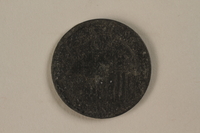
Łódź (Litzmannstadt) ghetto scrip, 5 mark coin
Object
5 mark coin token issued in 1943 in Łódź Ghetto in German occupied Poland. Nazi Germany invaded Poland on September 1, 1939, and occupied Łódź one week later. Łódź was renamed Litzmannstadt and, by February 1940, the Germans forcibly relocated the large Jewish population of 160,000 into a small, sealed ghetto. Residents had to do forced labor, many in ghetto factories. Residents were forbidden to have German currency, and the Jewish Council was ordered to create a system of Quittungen [receipts] for use only in the Ghetto. Coins were issued in 4 denominations: 10 pfennig, and 5,10, and 20 mark. Paper scrip was issued in 7 denominations: 50 pfenning, 1, 2, 5, 10, 20, 50, and 100 marks. It acted as a labor incentive and facilitated the confiscation of money and goods from internees. There was little to exchange it for in the Ghetto. Living conditions were horrendous; the severe overcrowding and lack of food made disease and starvation common. In January 1942, mass deportations to Chelmno killing center began; half the residents were murdered by the end of the year. In summer 1944, Łódź, the last ghetto in Poland, was destroyed and the remaining Jews were sent to Chelmno and Auschwitz-Birkenau killing centers.
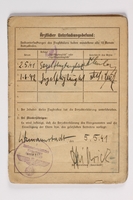
Nationalsozialistisches Fliegerkorps flight logbook with entries
Object
Flight logbook with many handwritten entries used by the Nationalsozialistisches Fliegerkorps [NSFK: National Socialist Flying Corps] of unknown origin. NSFK was a paramilitary organization founded in 1937 and affiliated with the Nazi Party. It was primarily involved with training and civil air defense.



